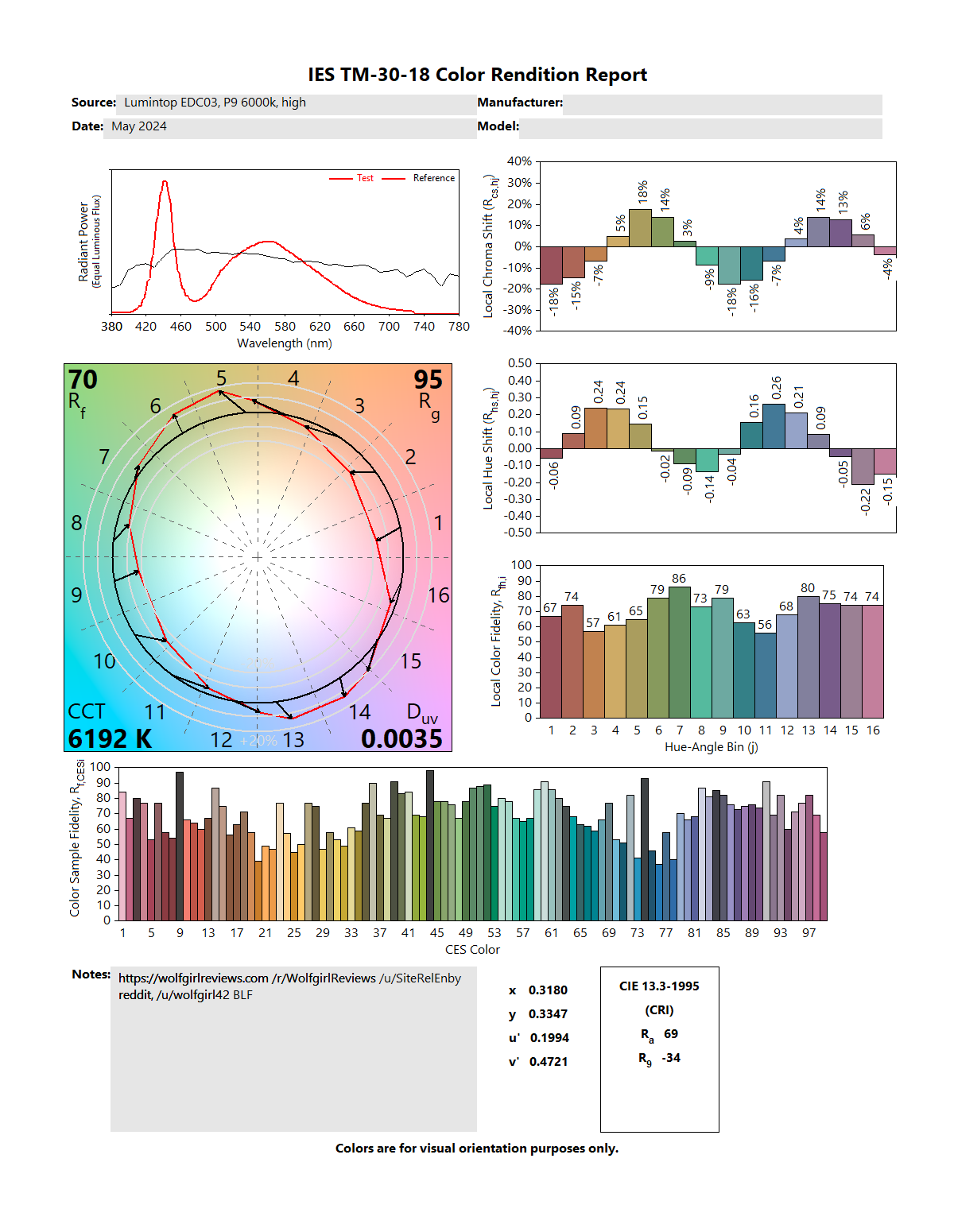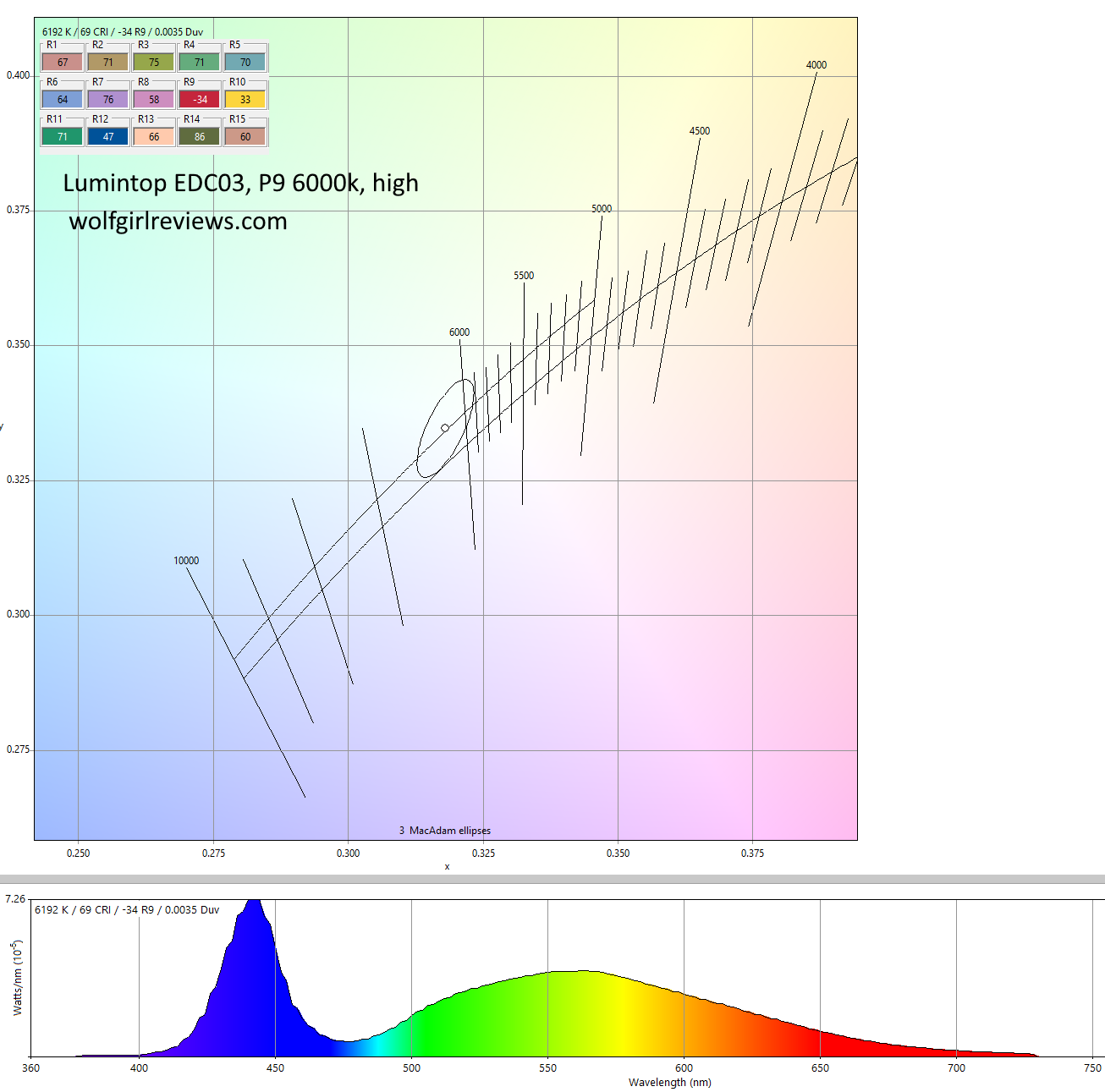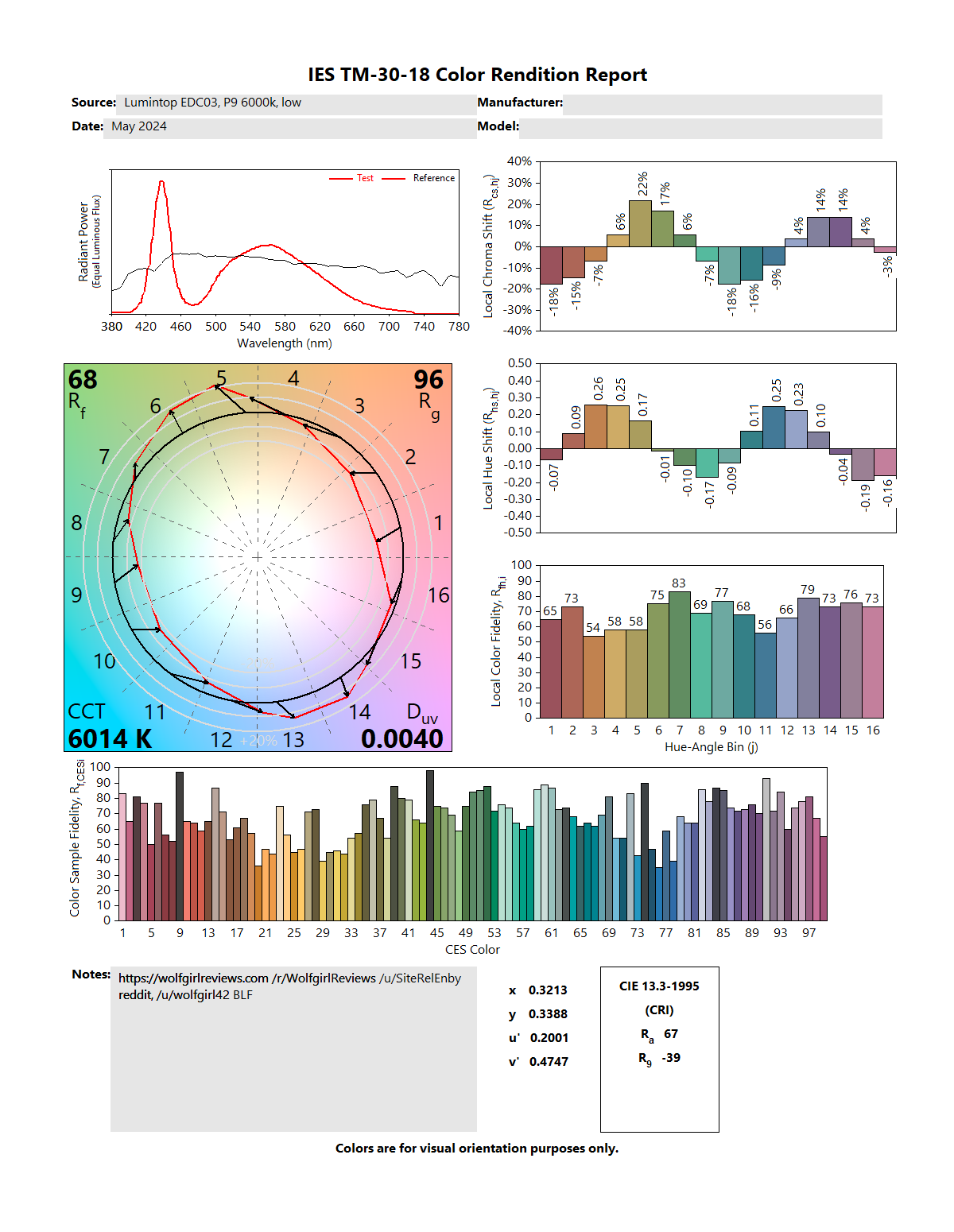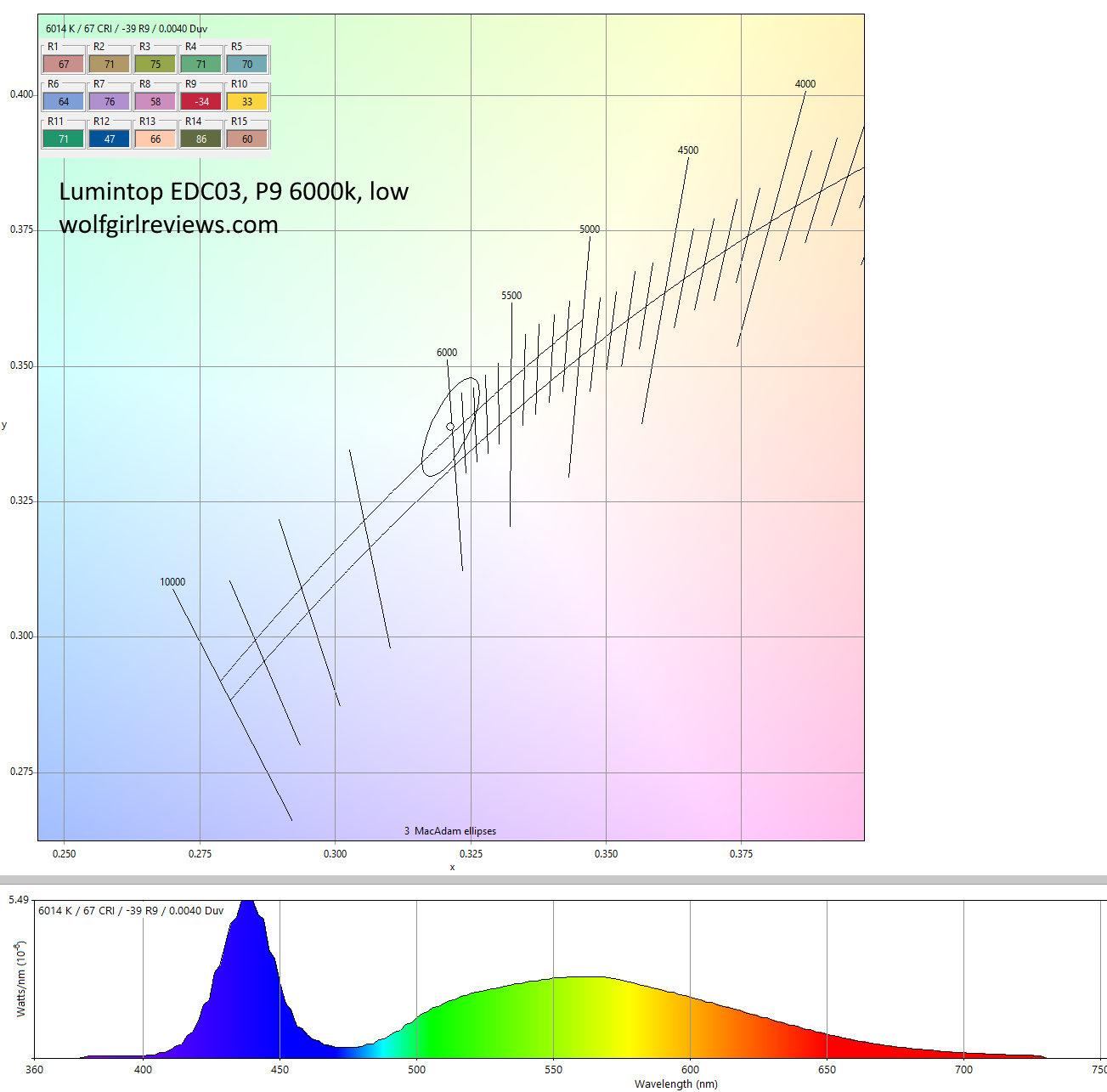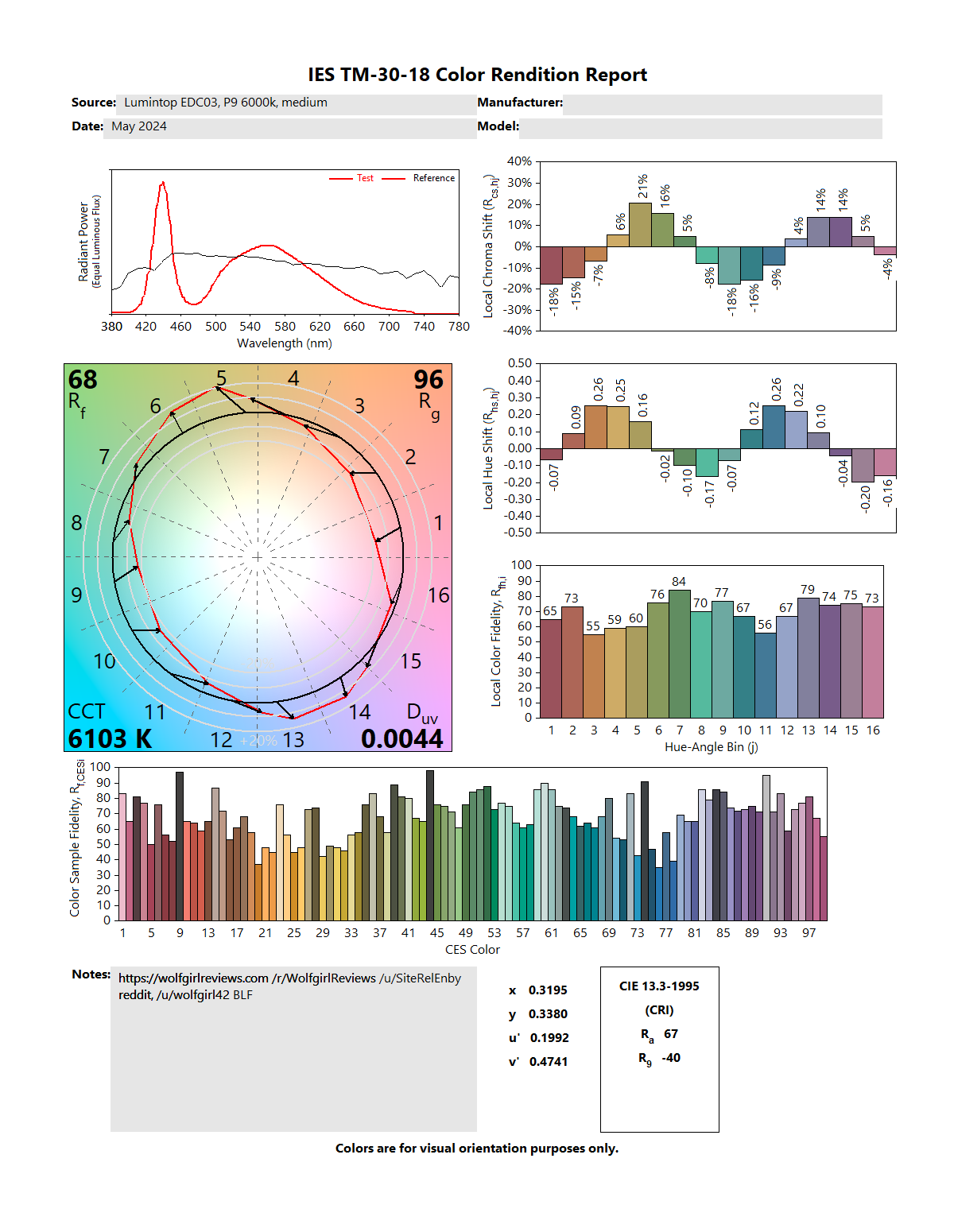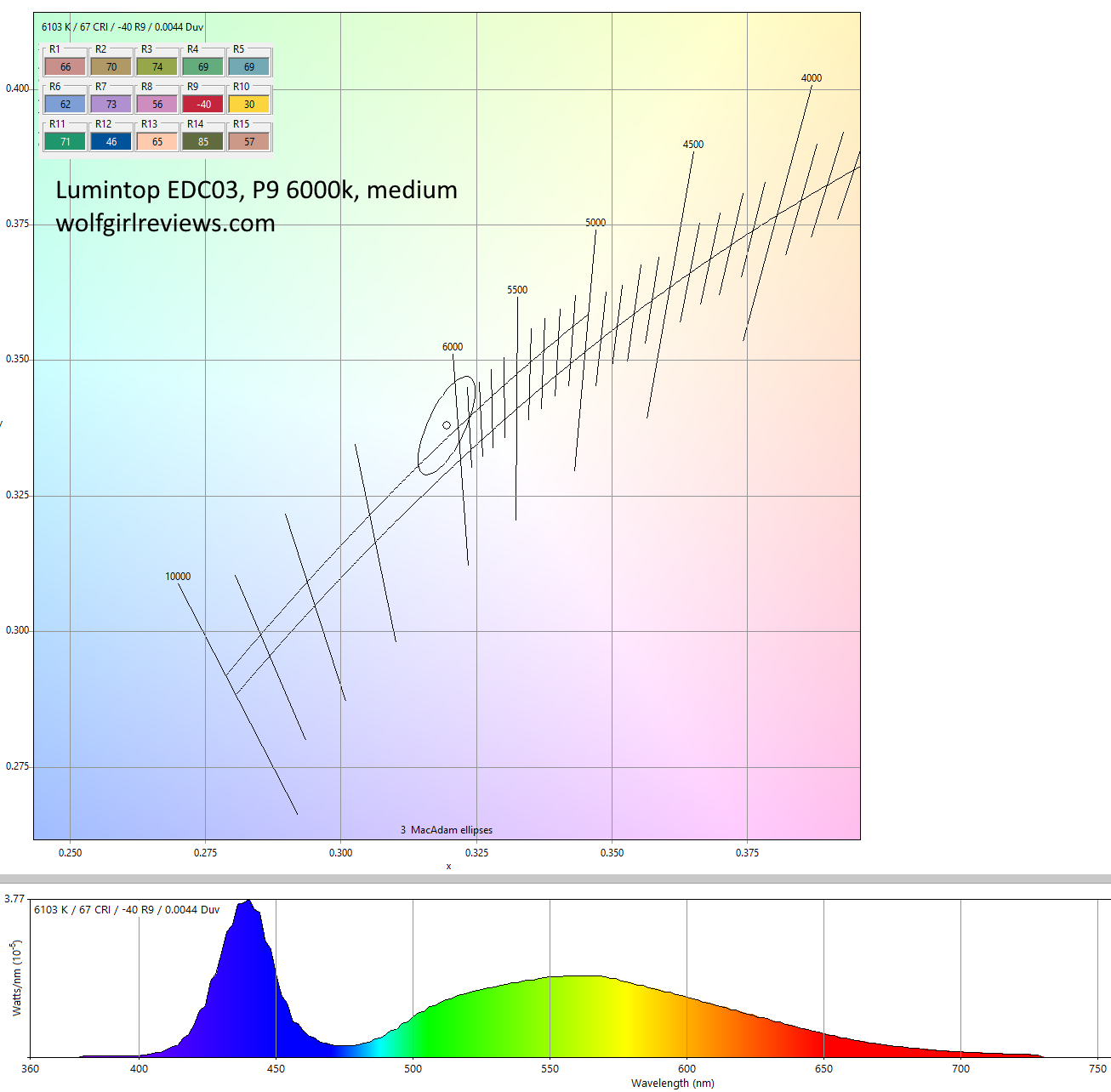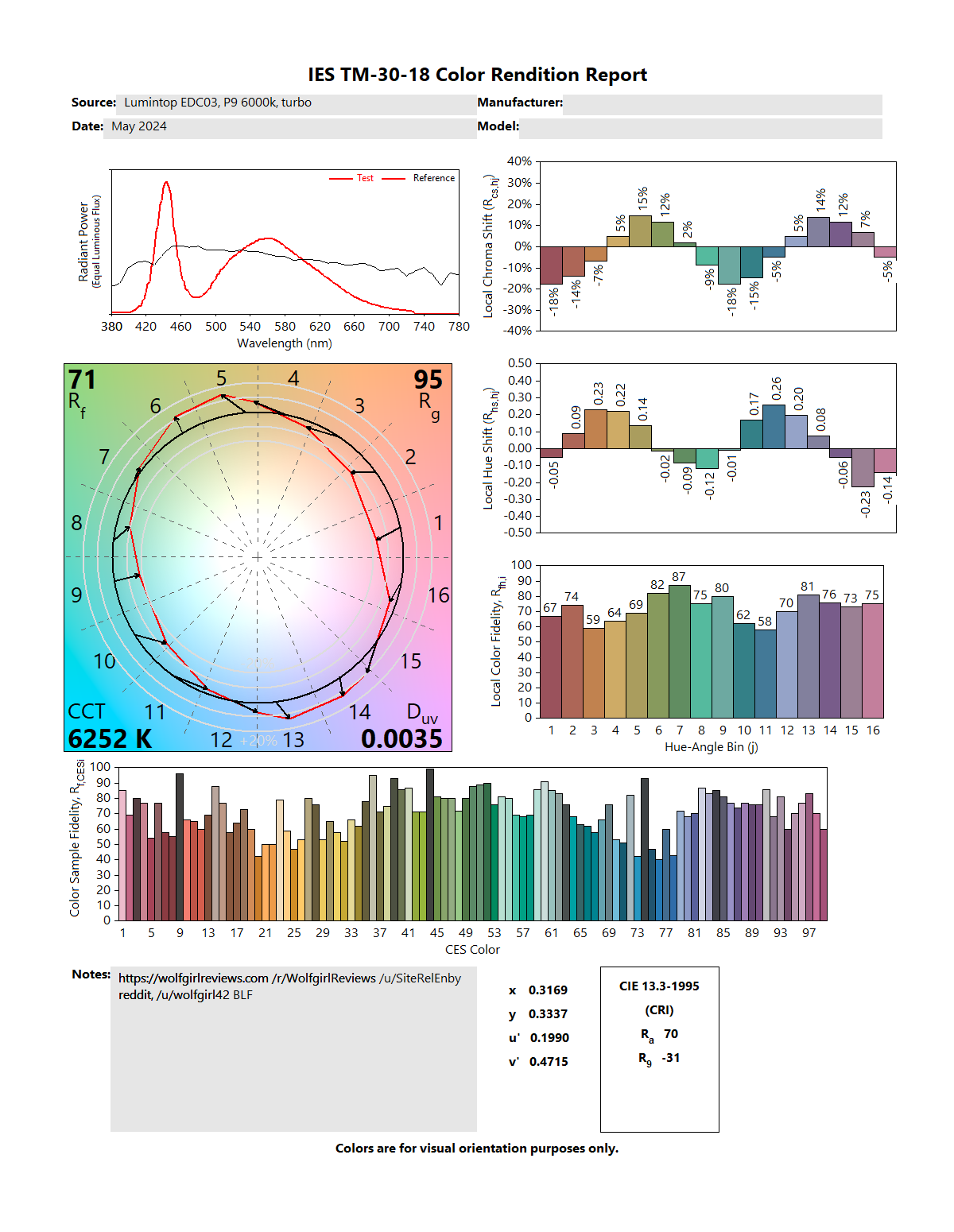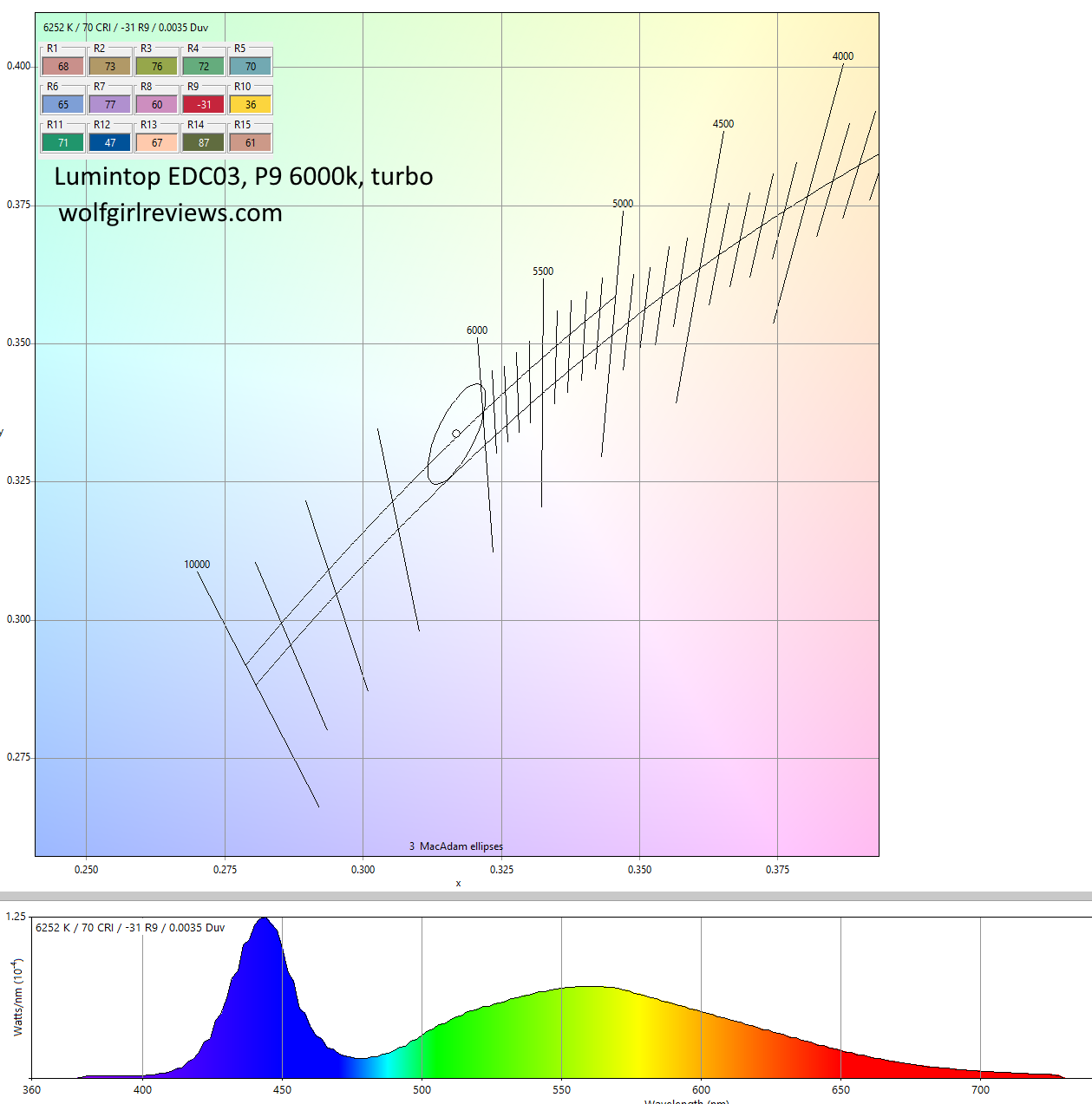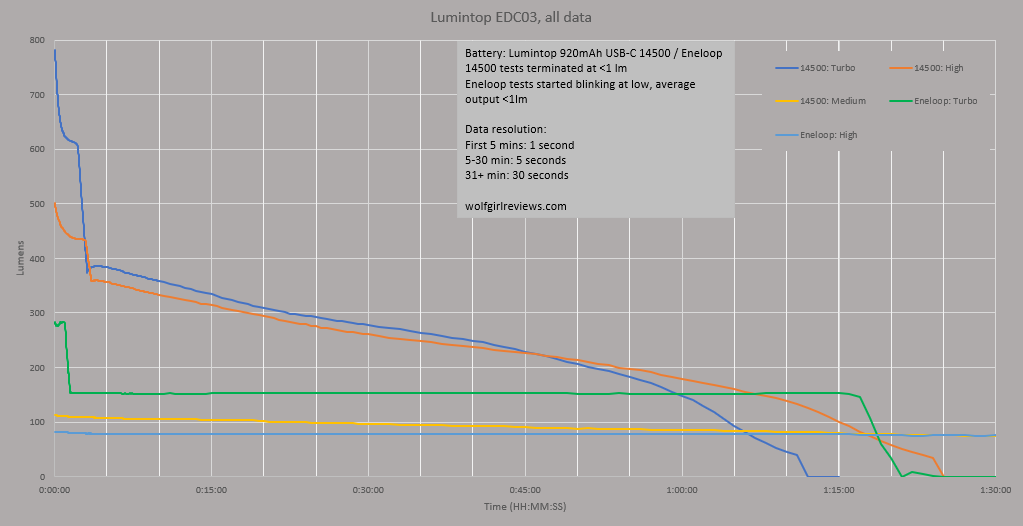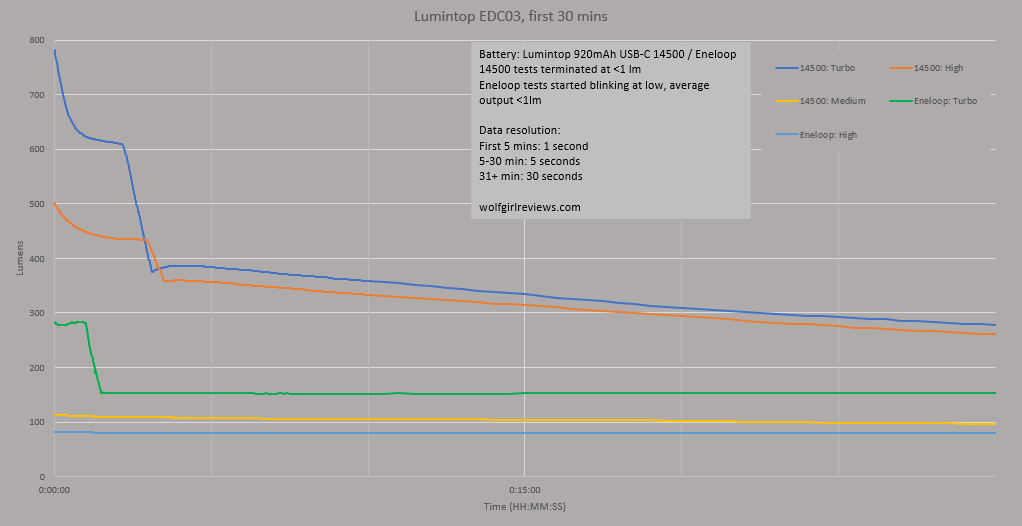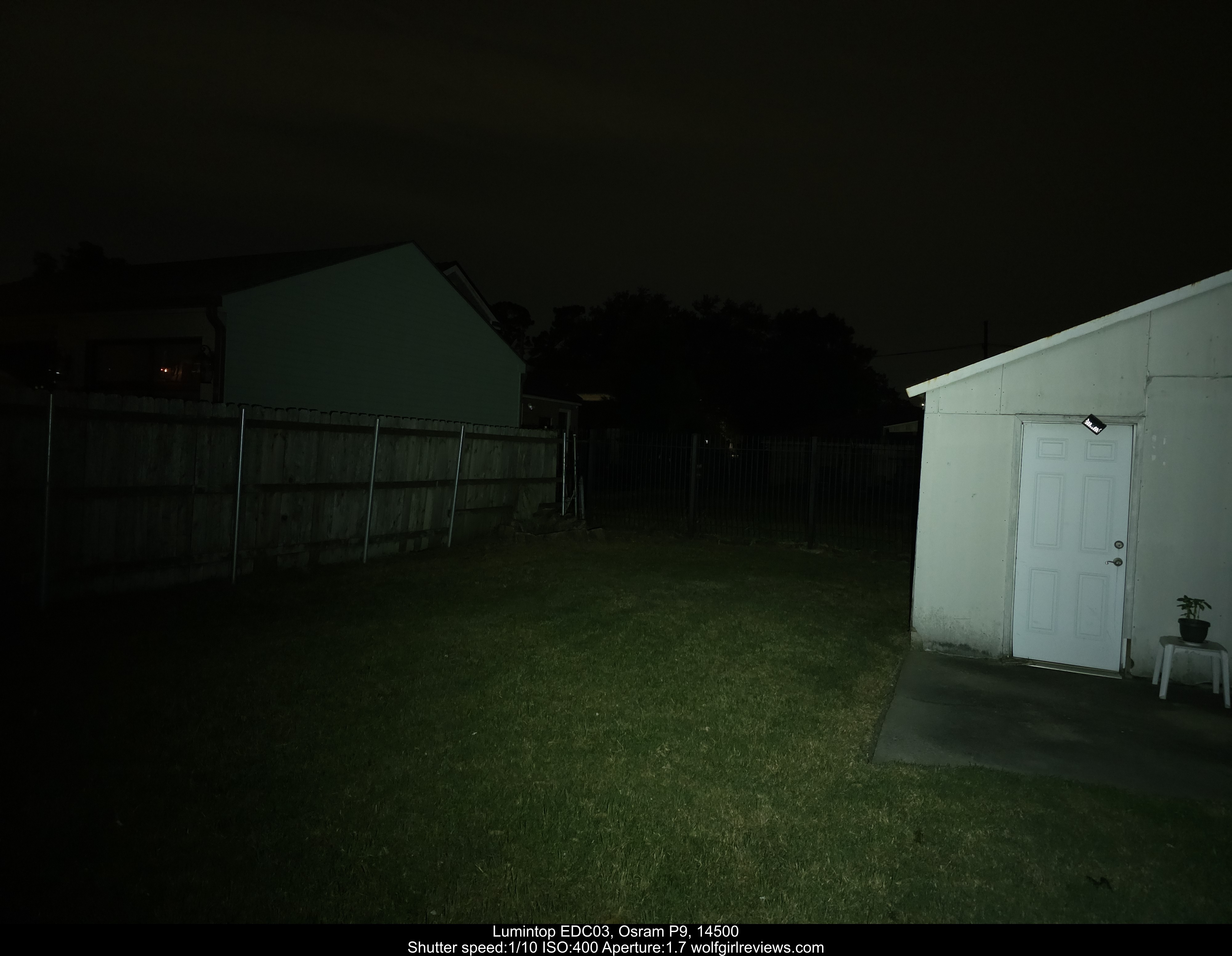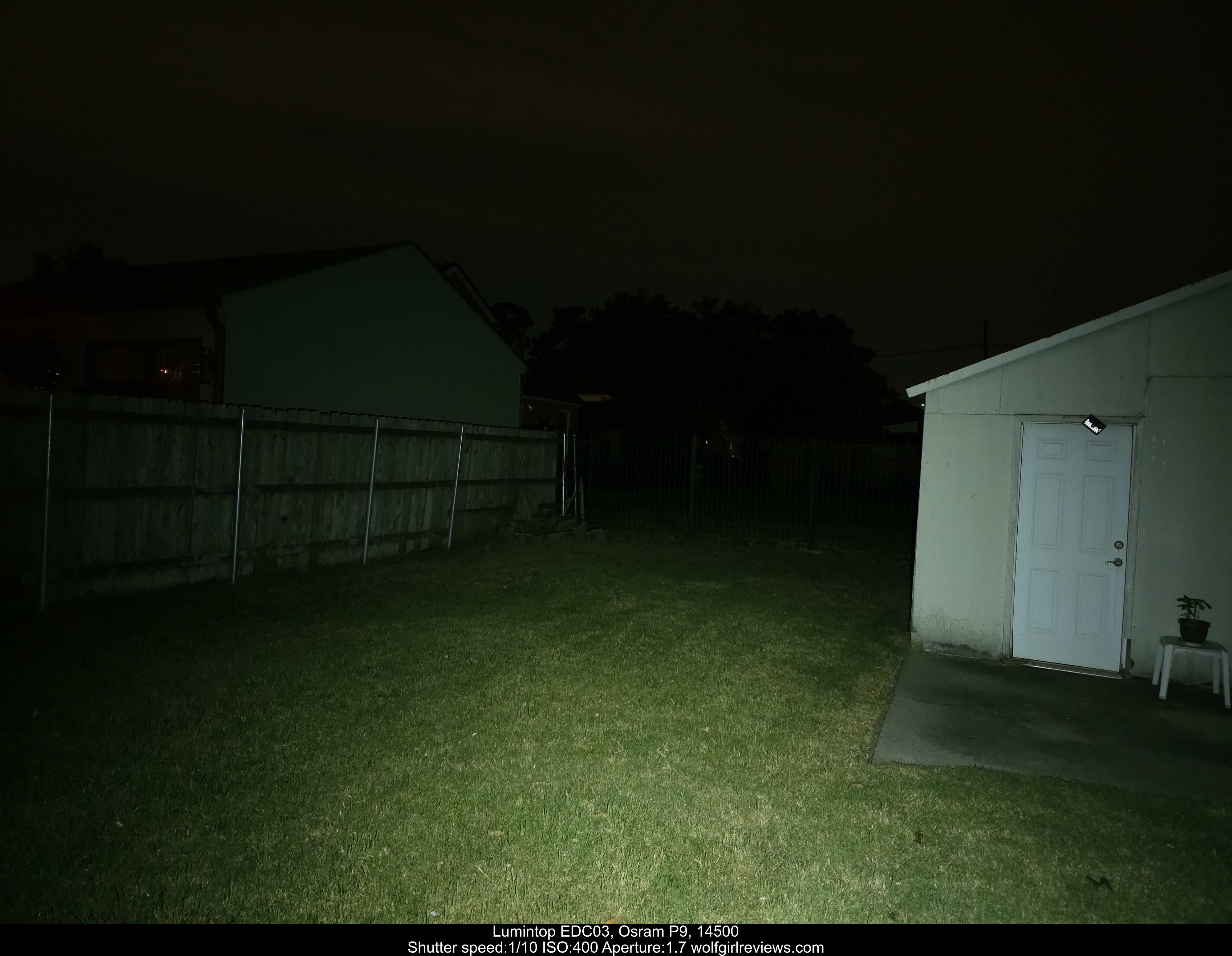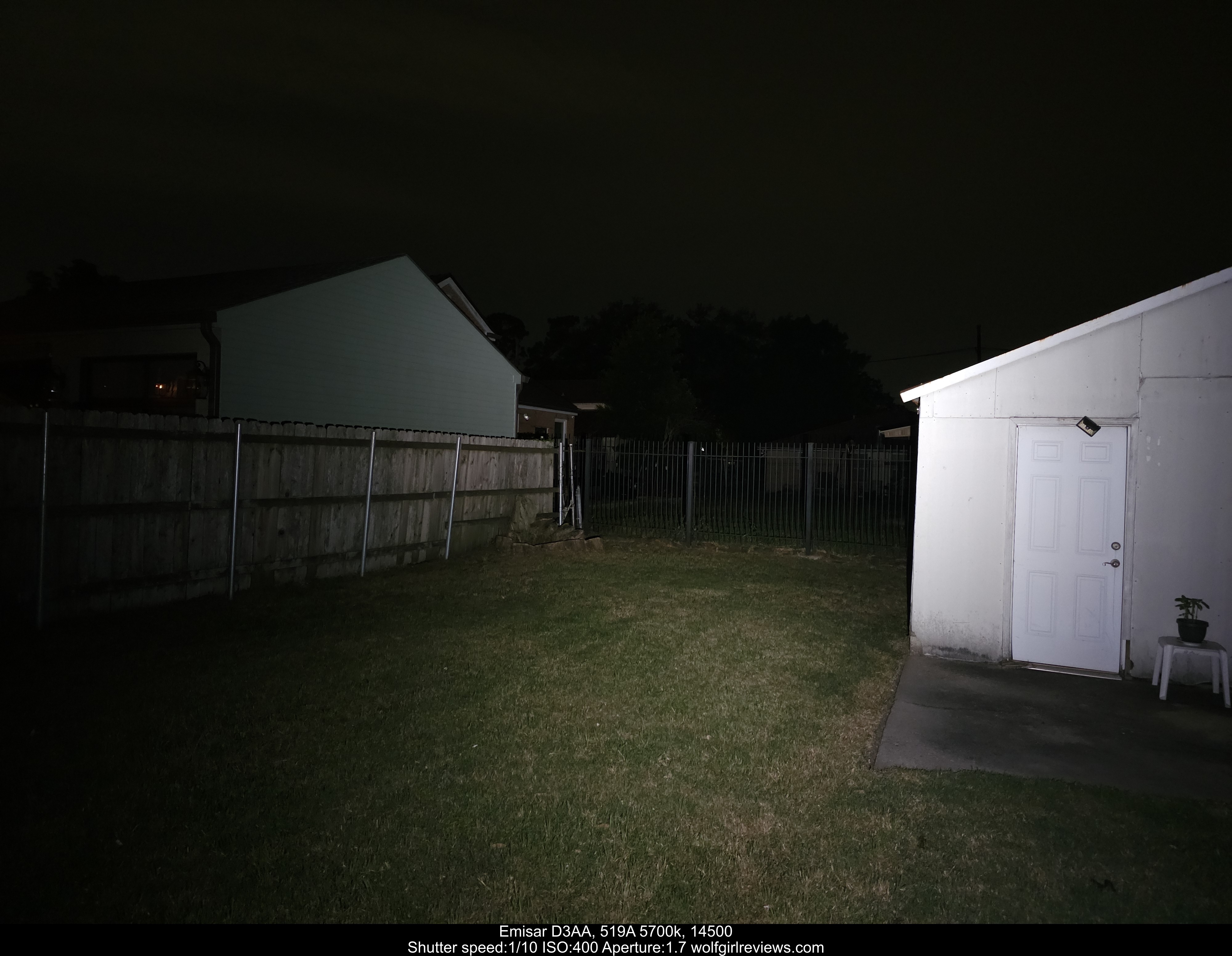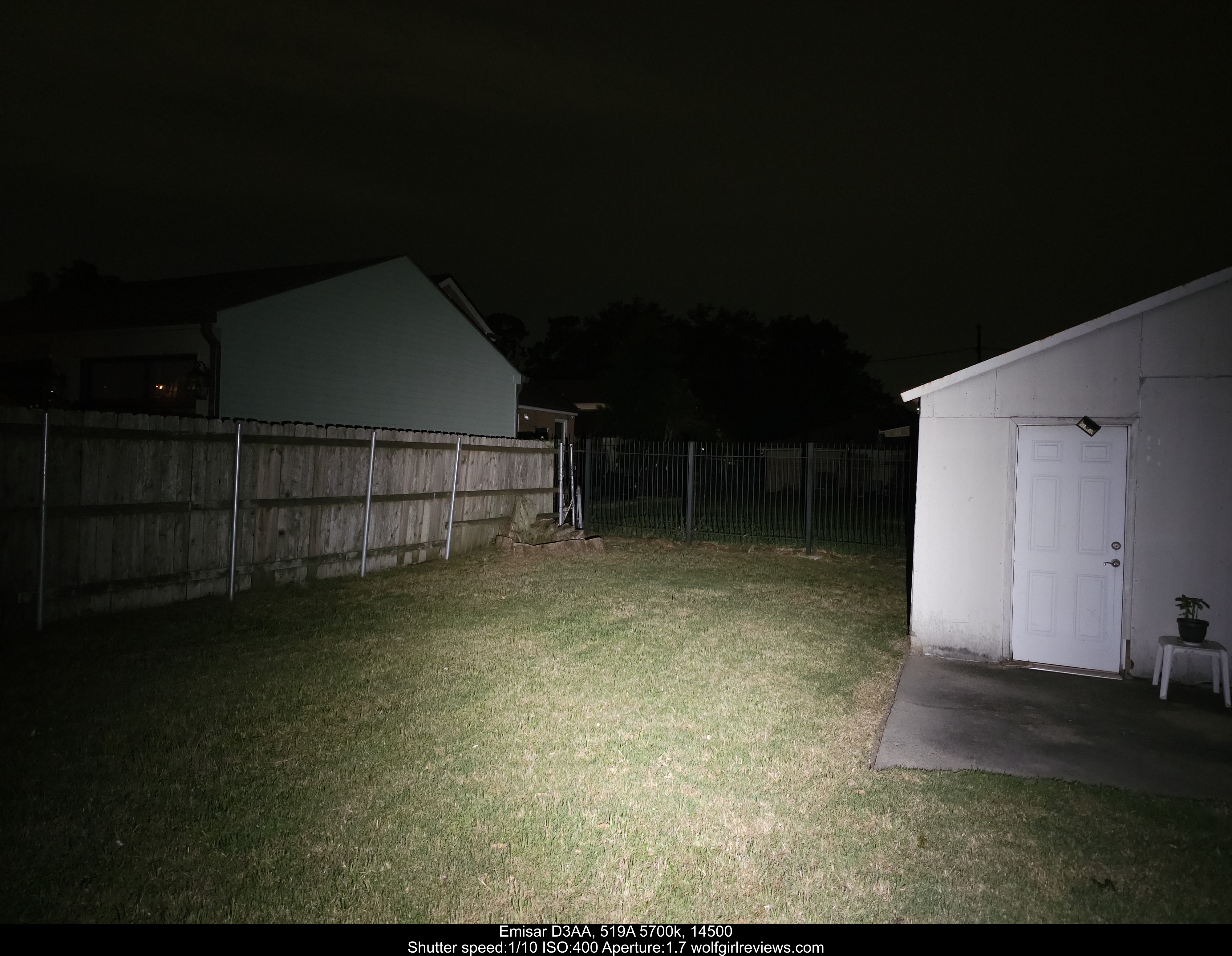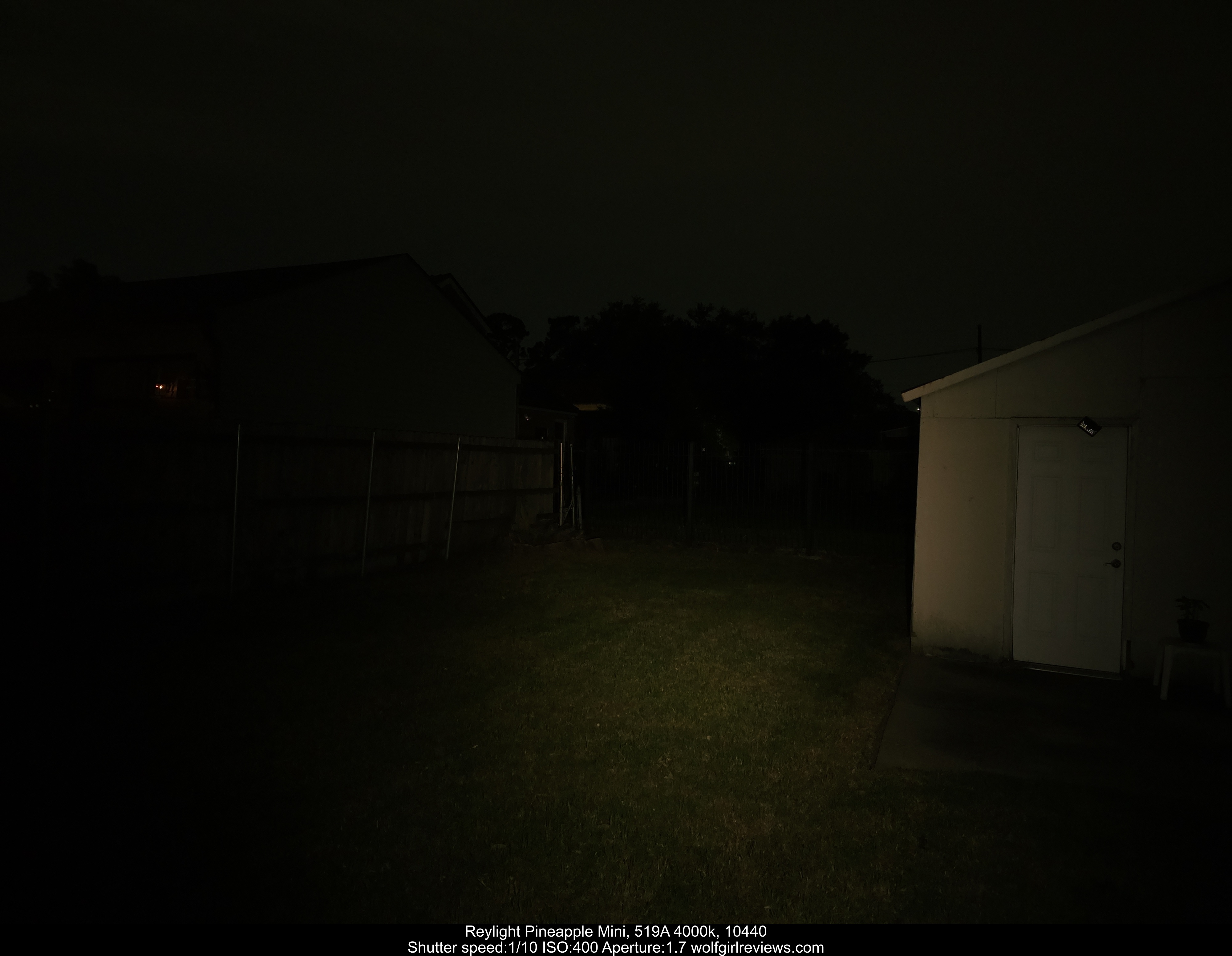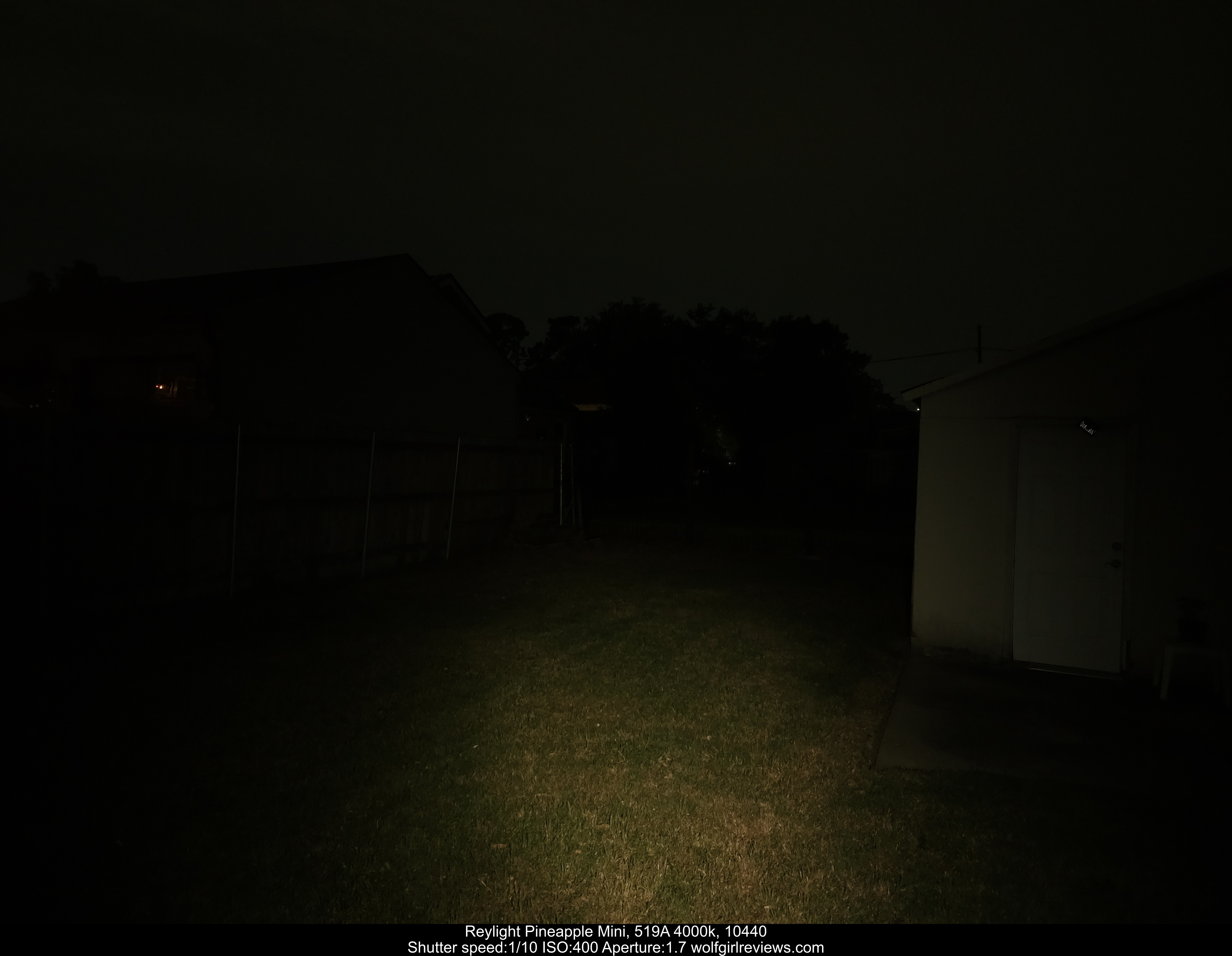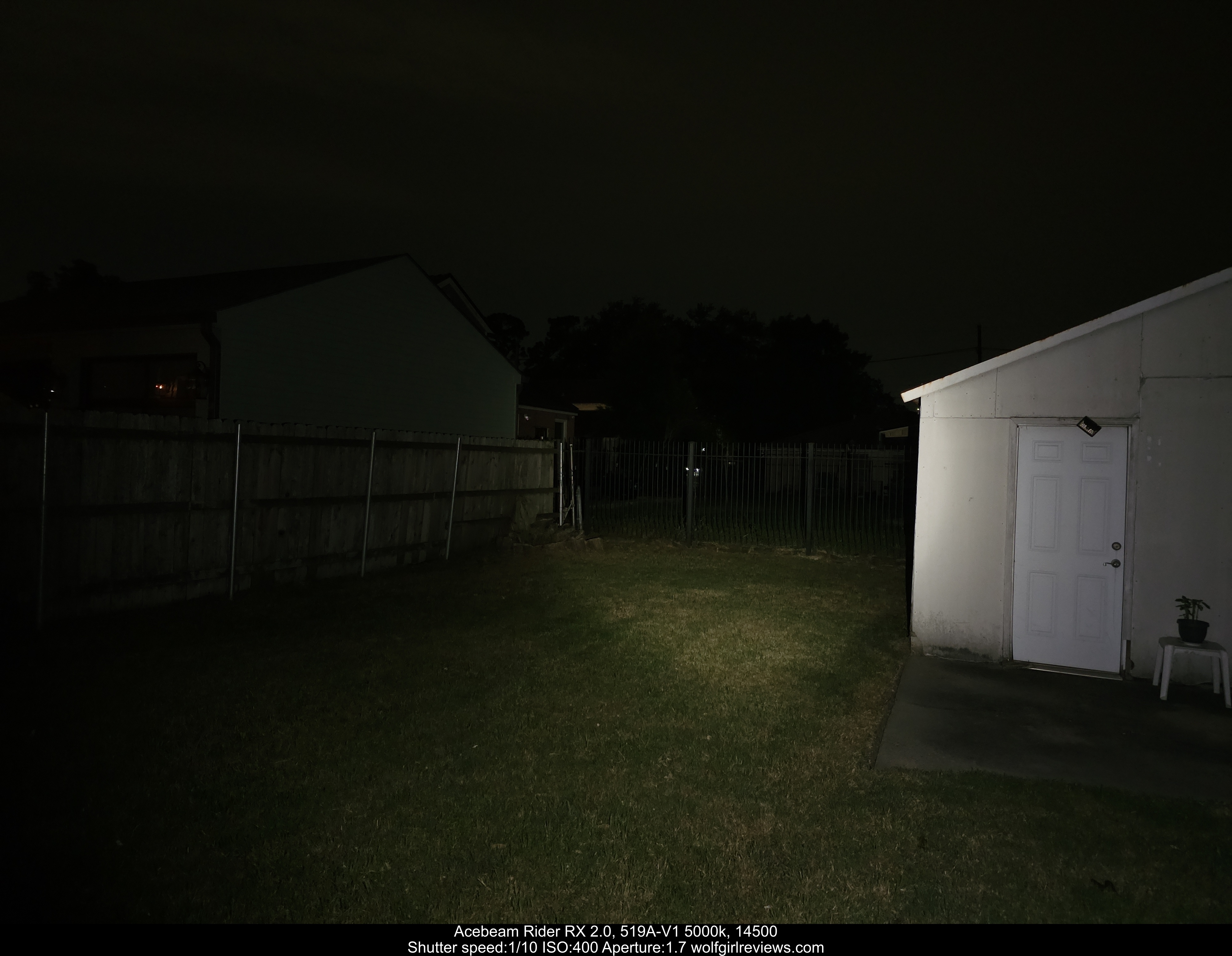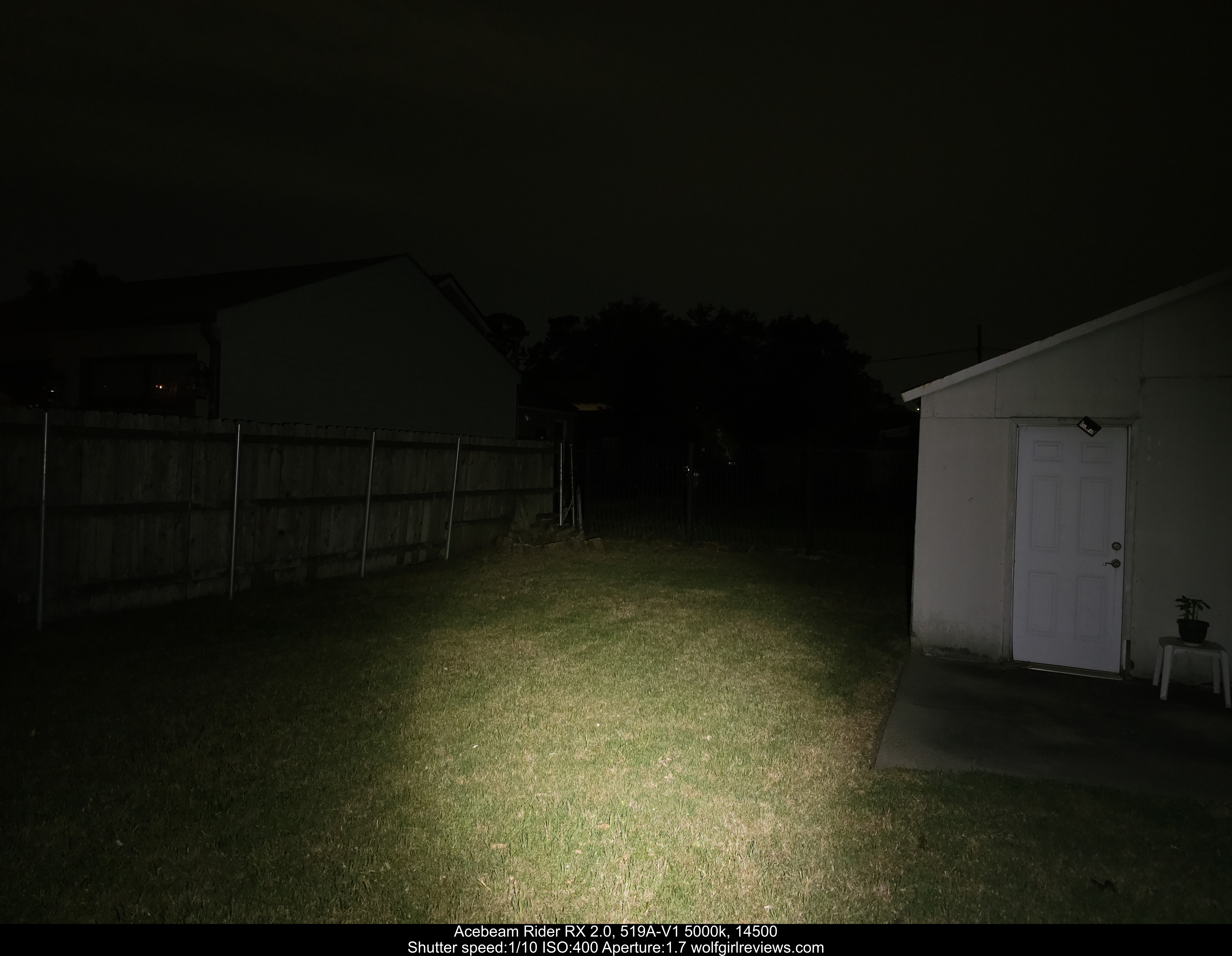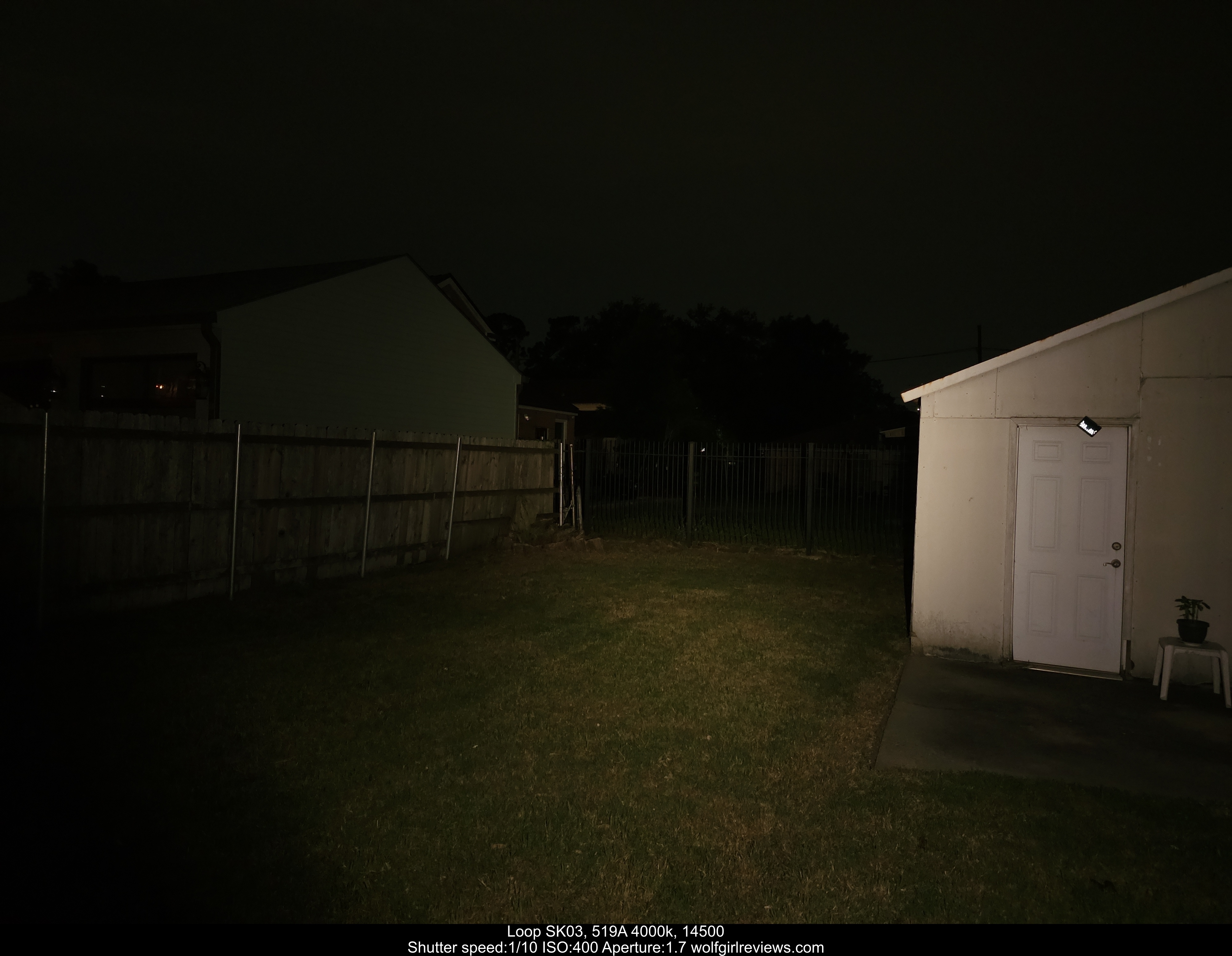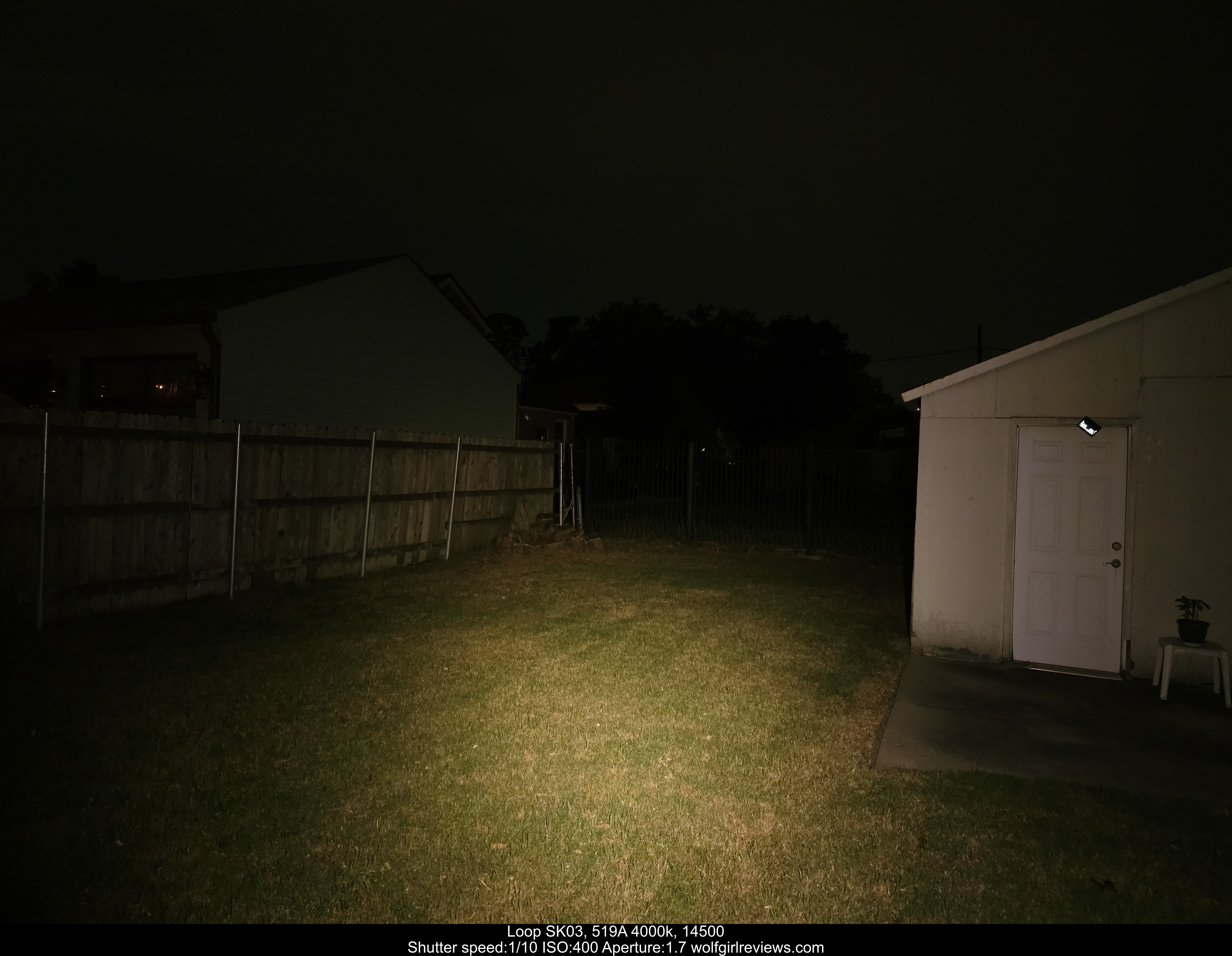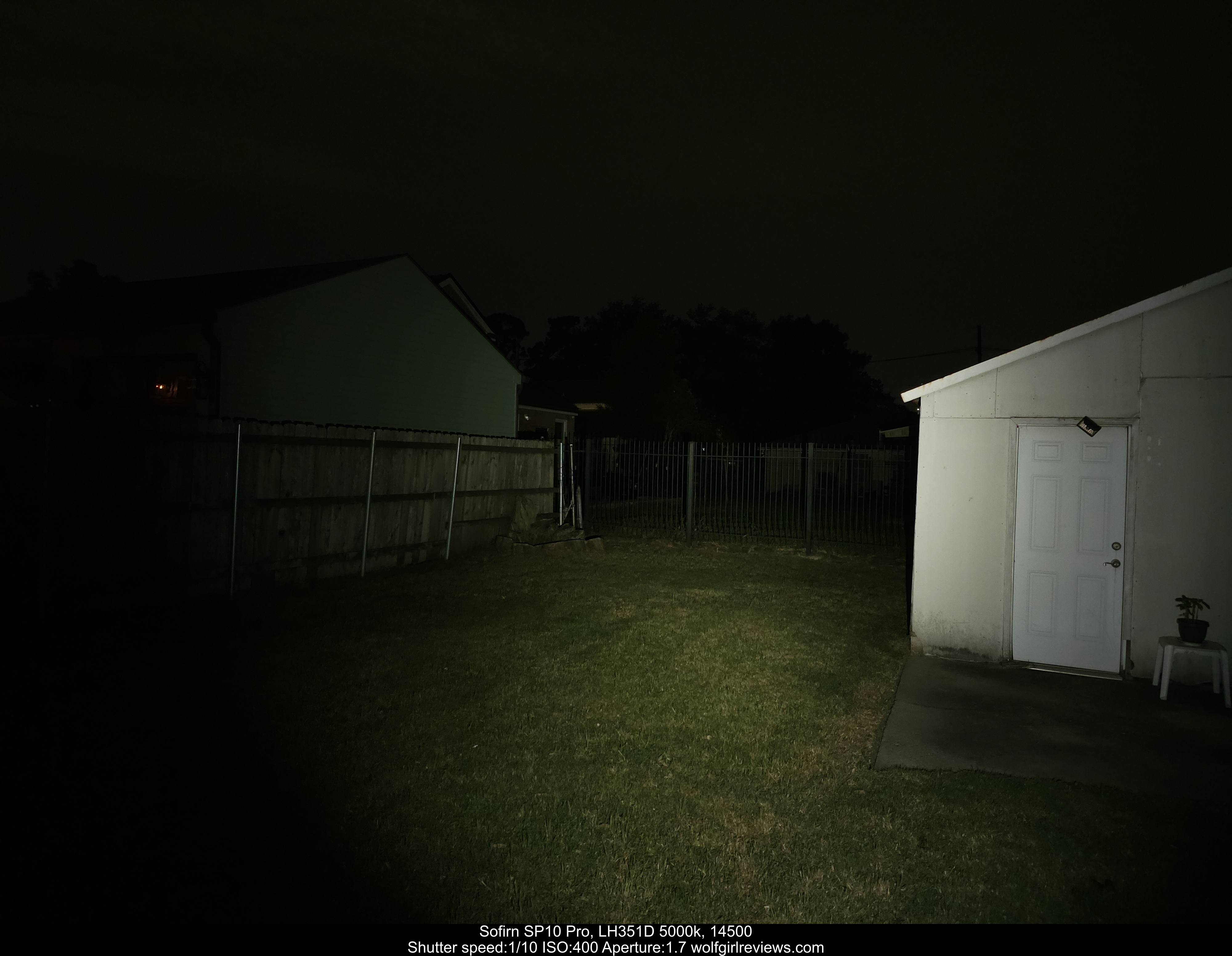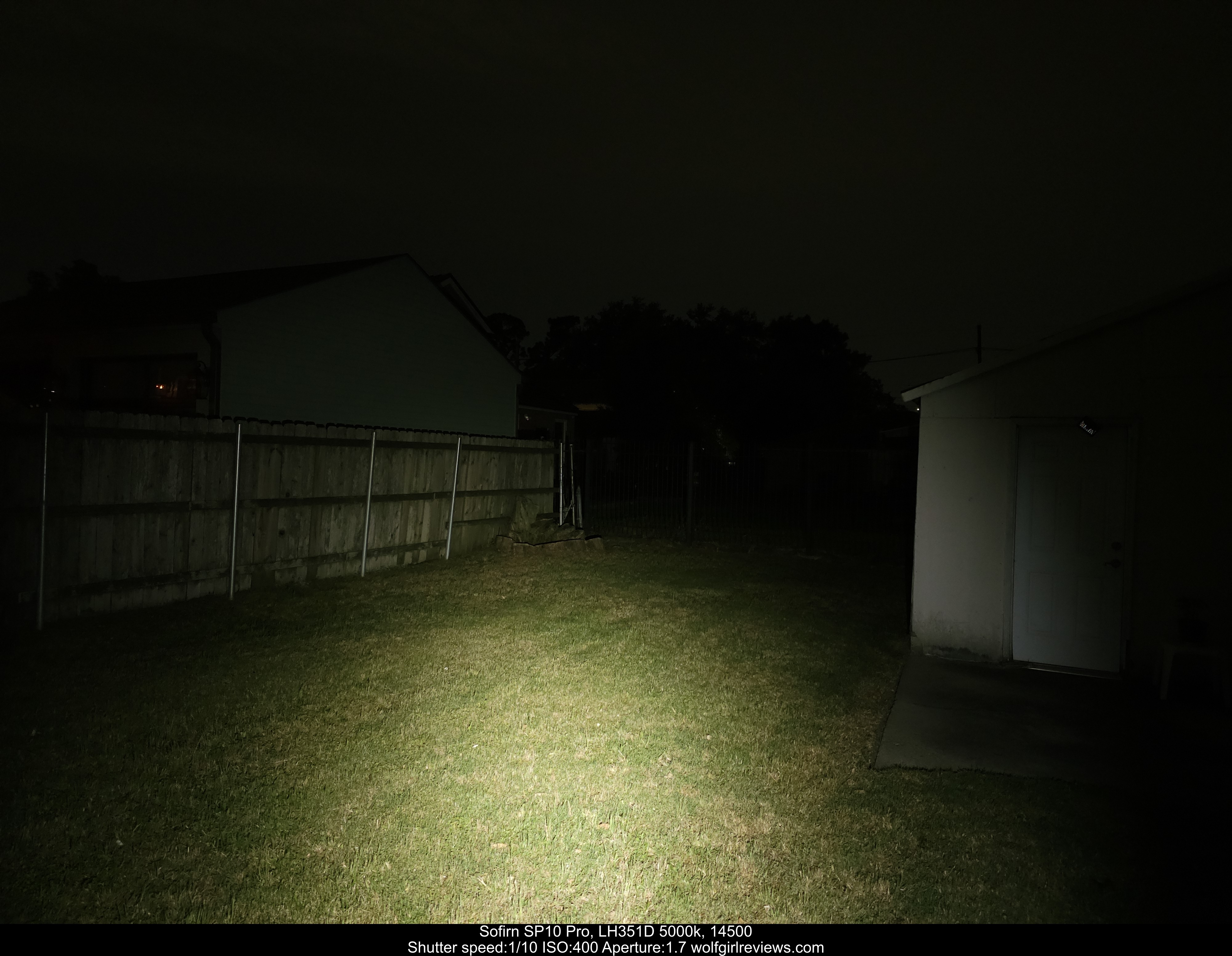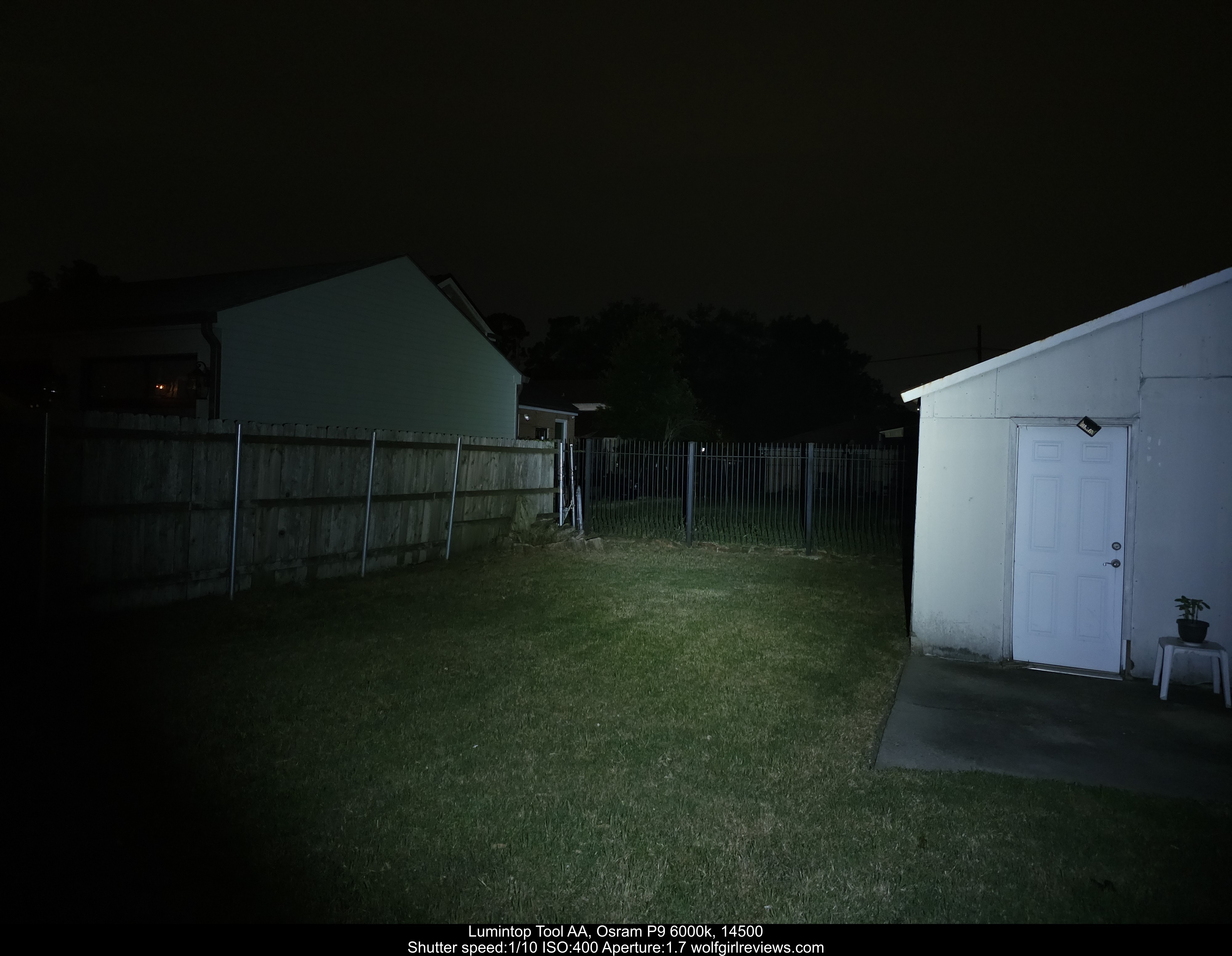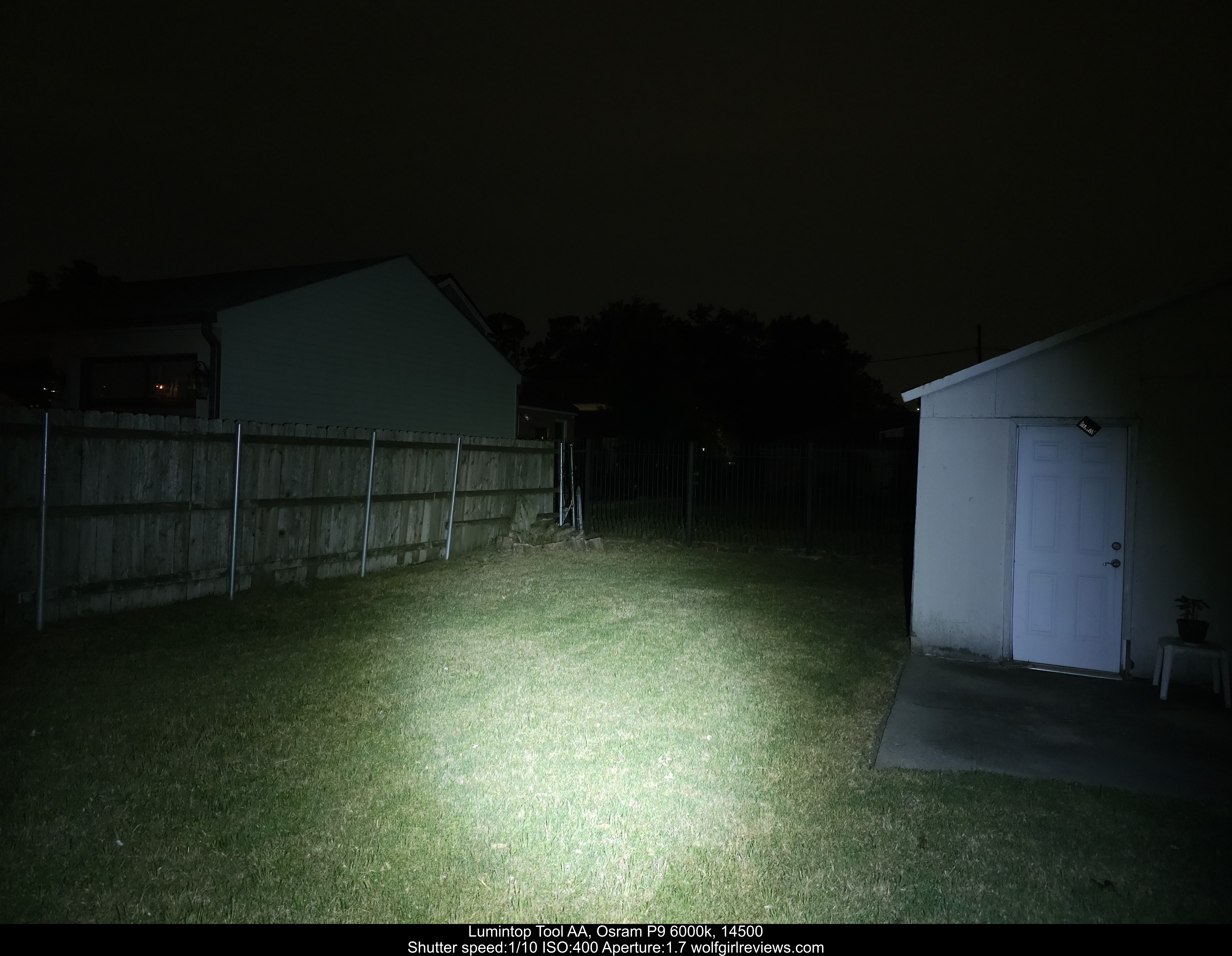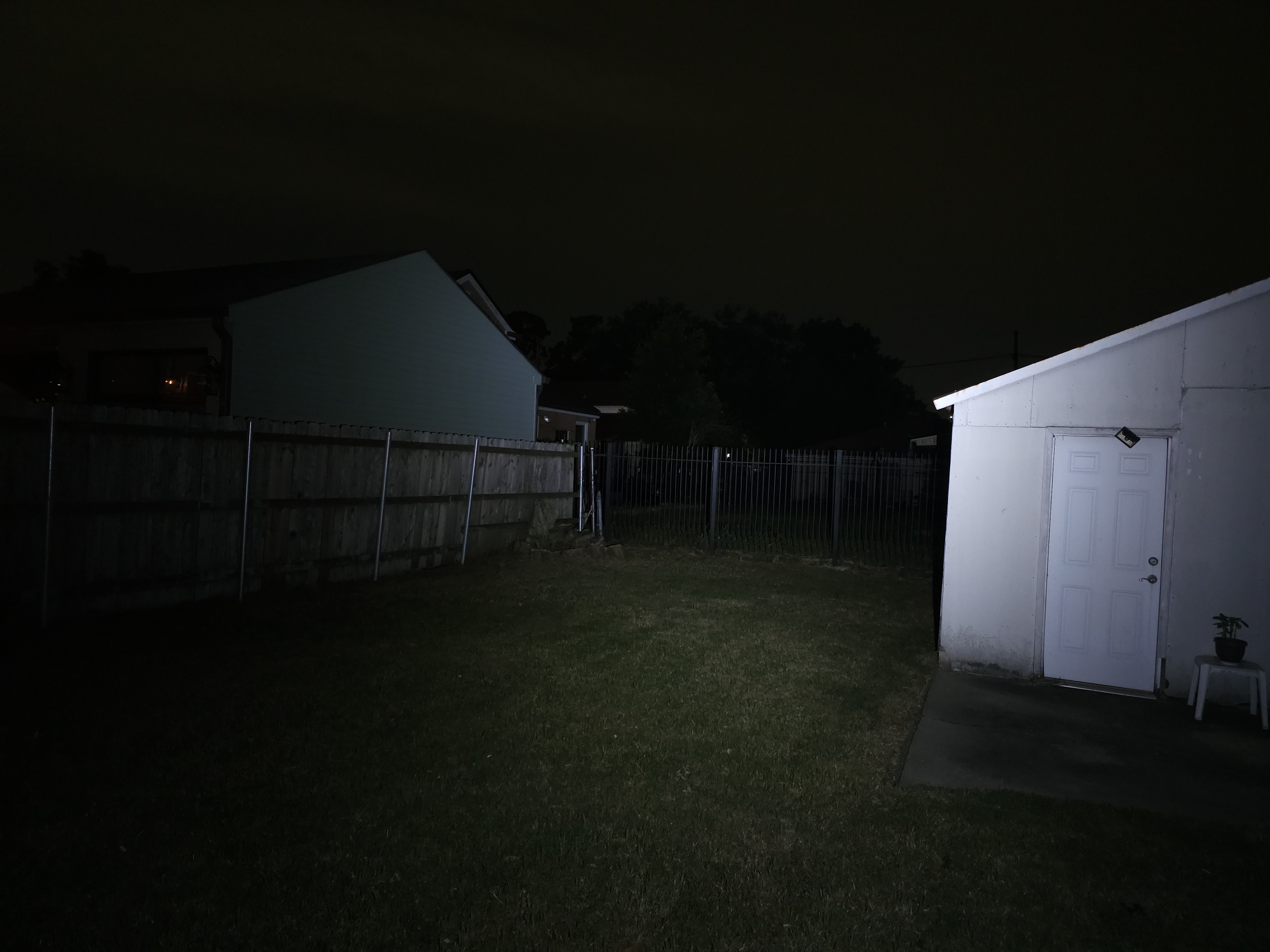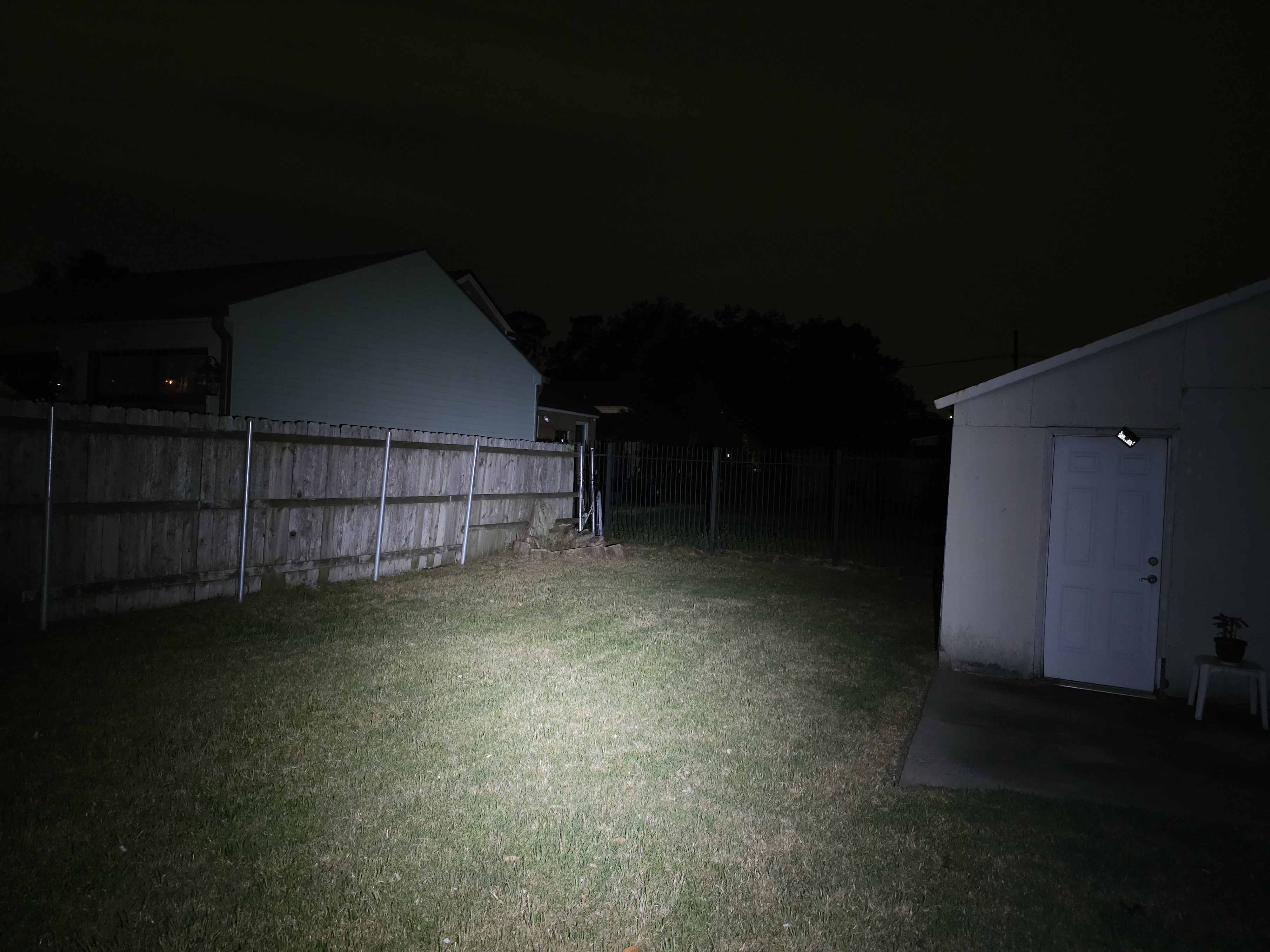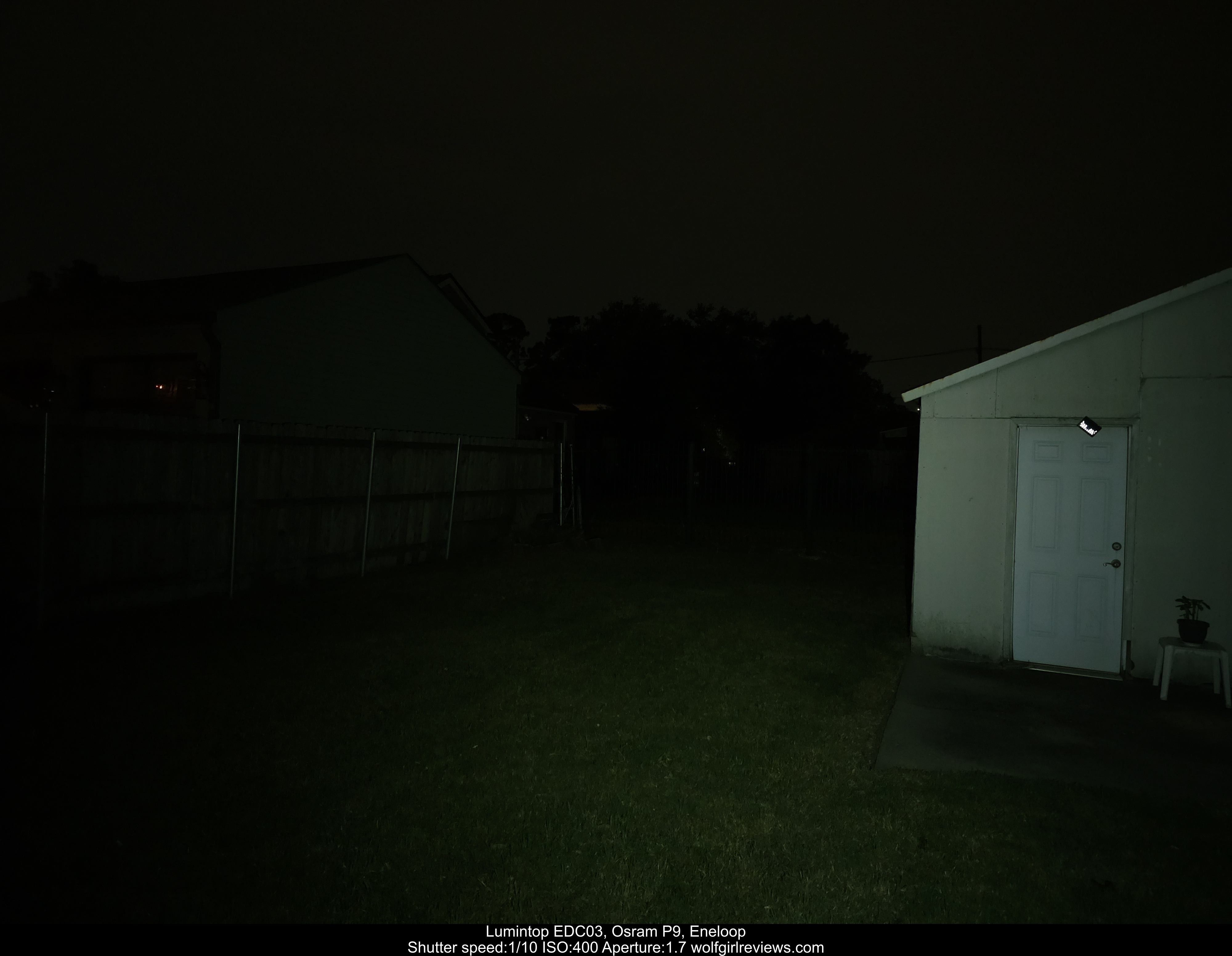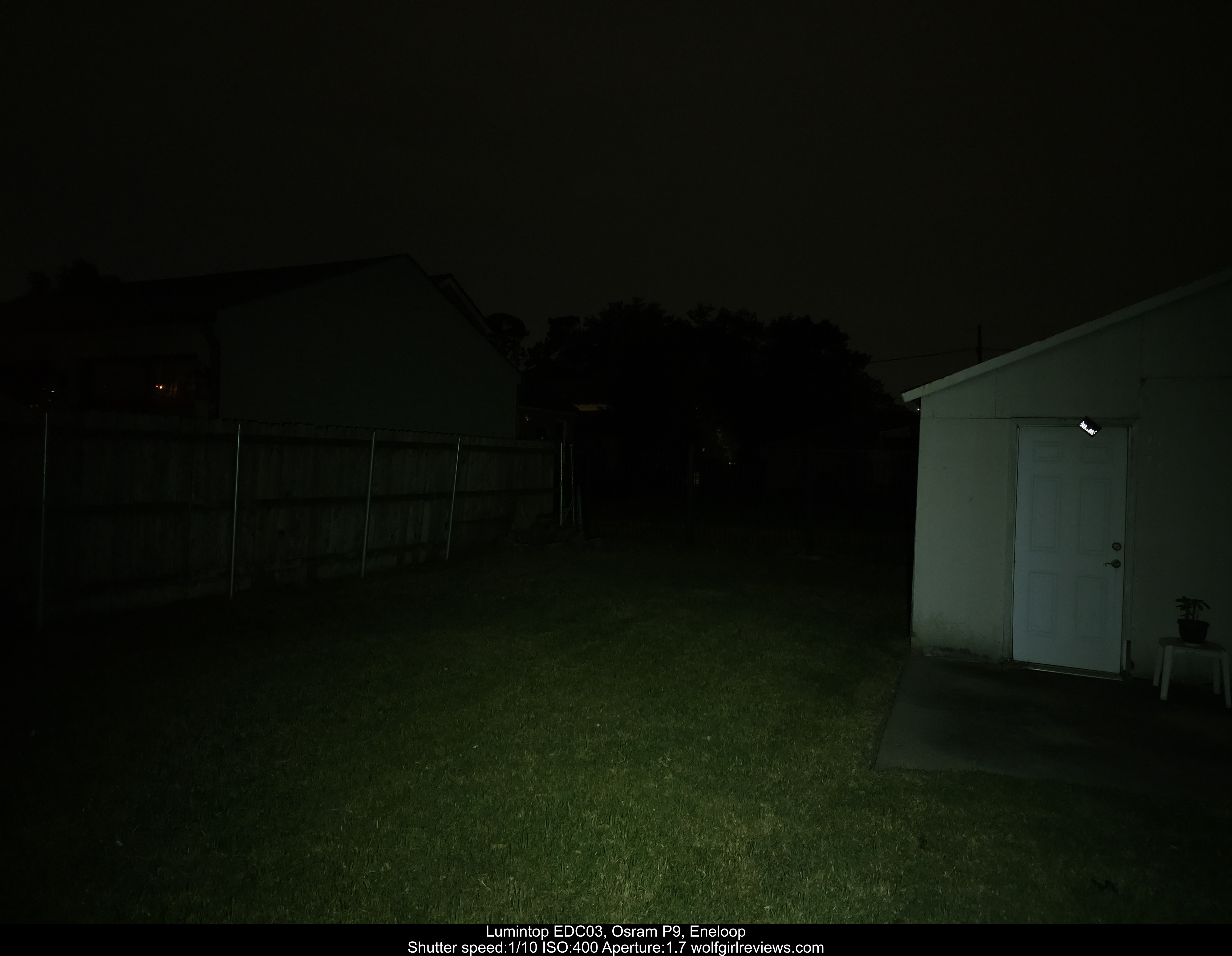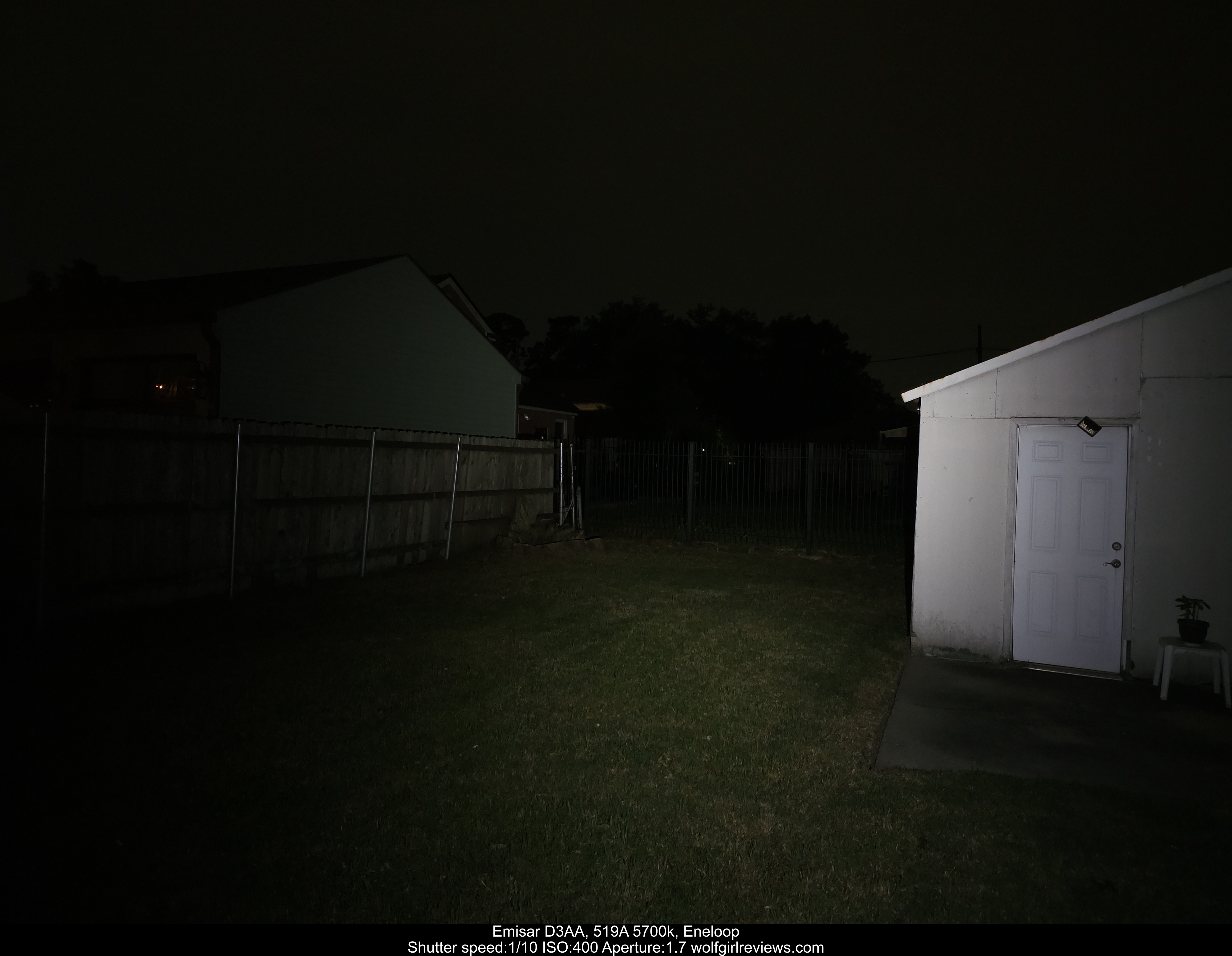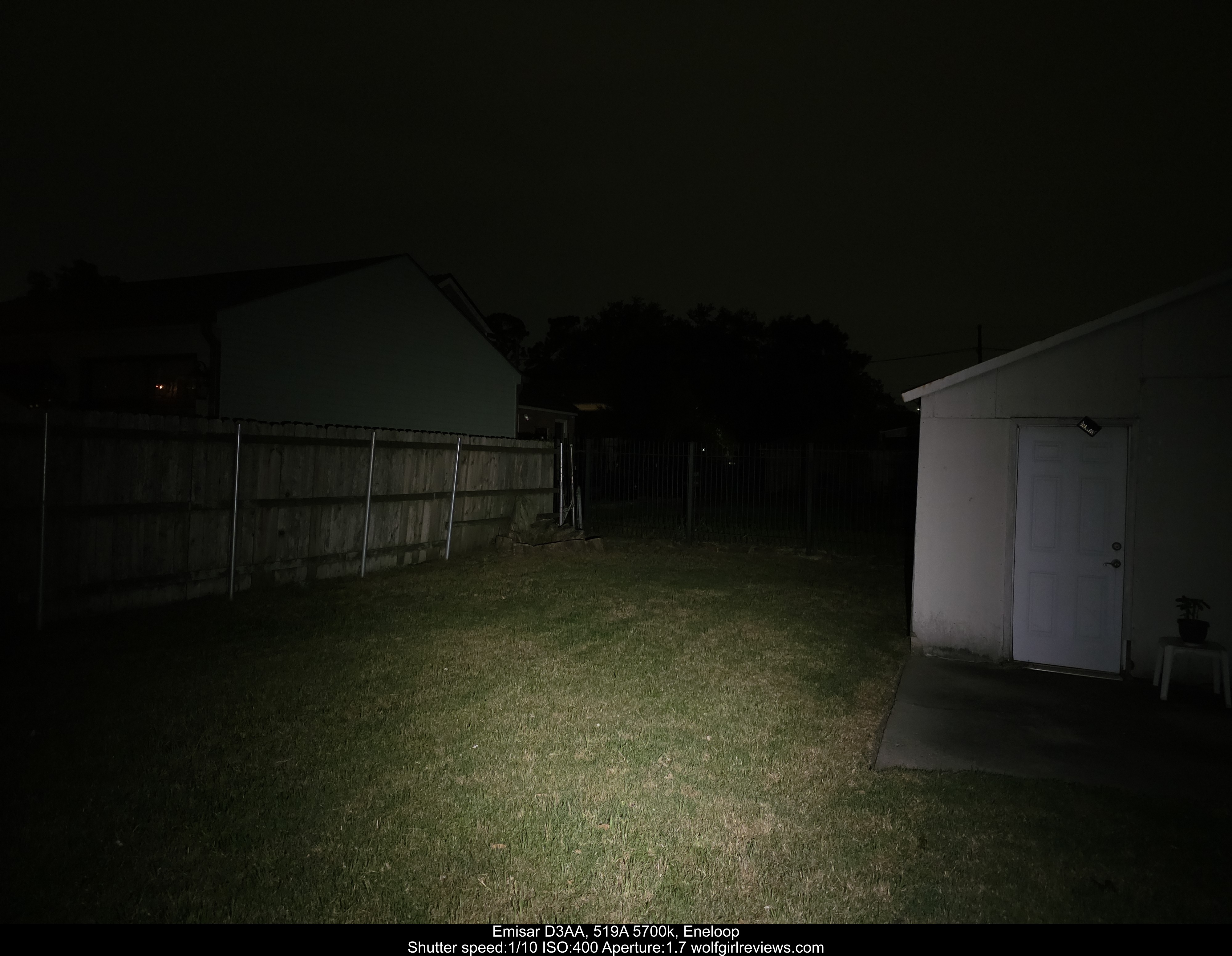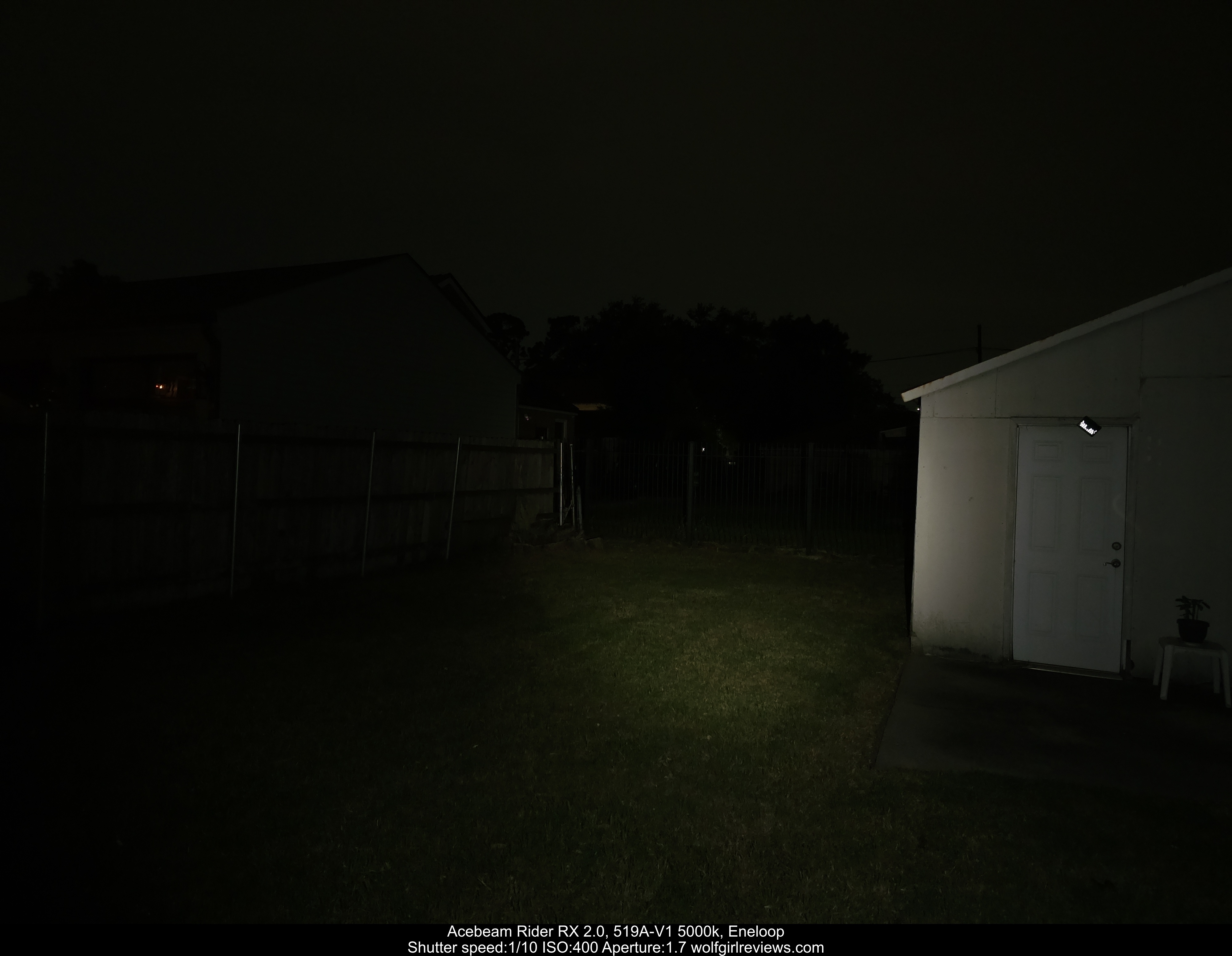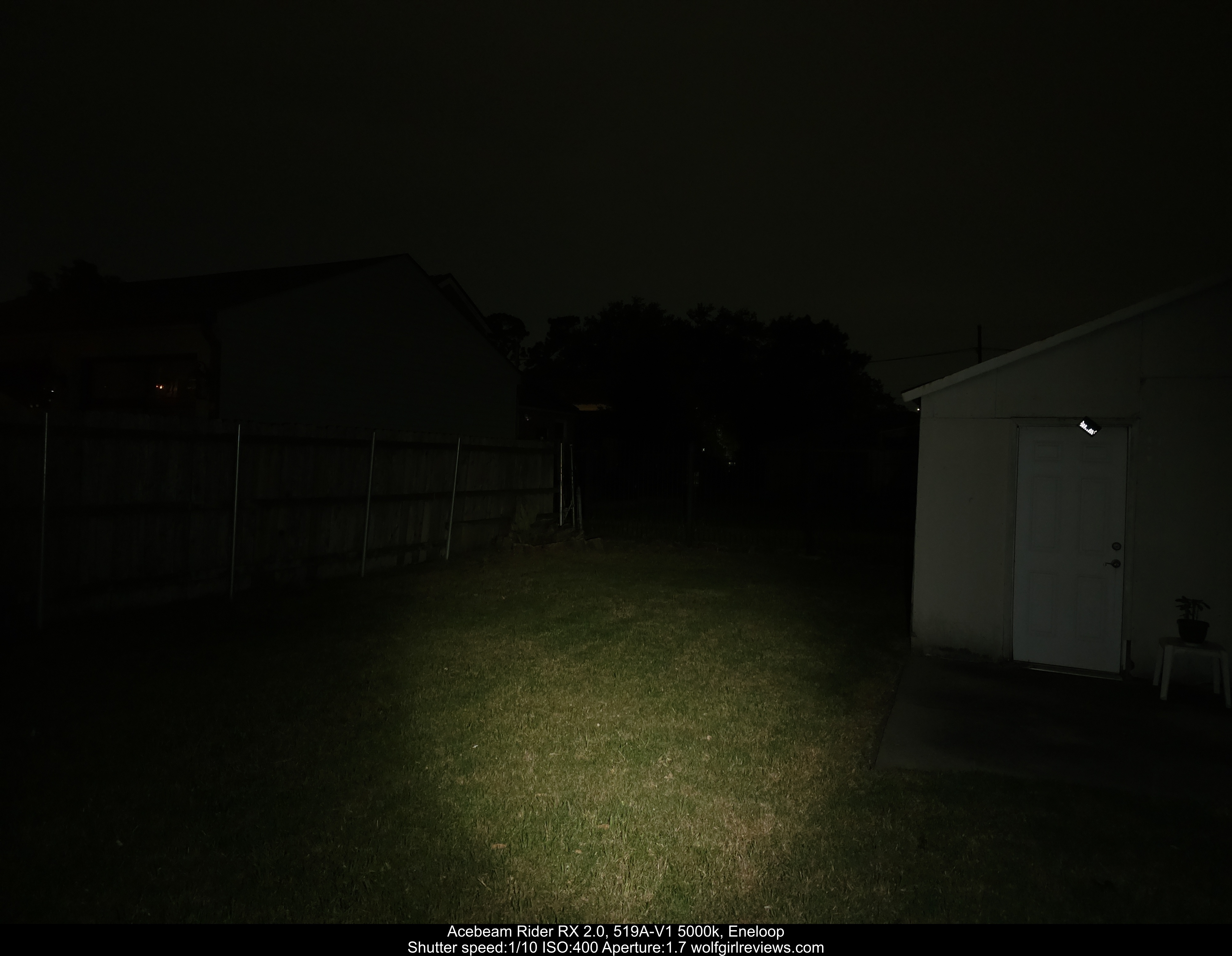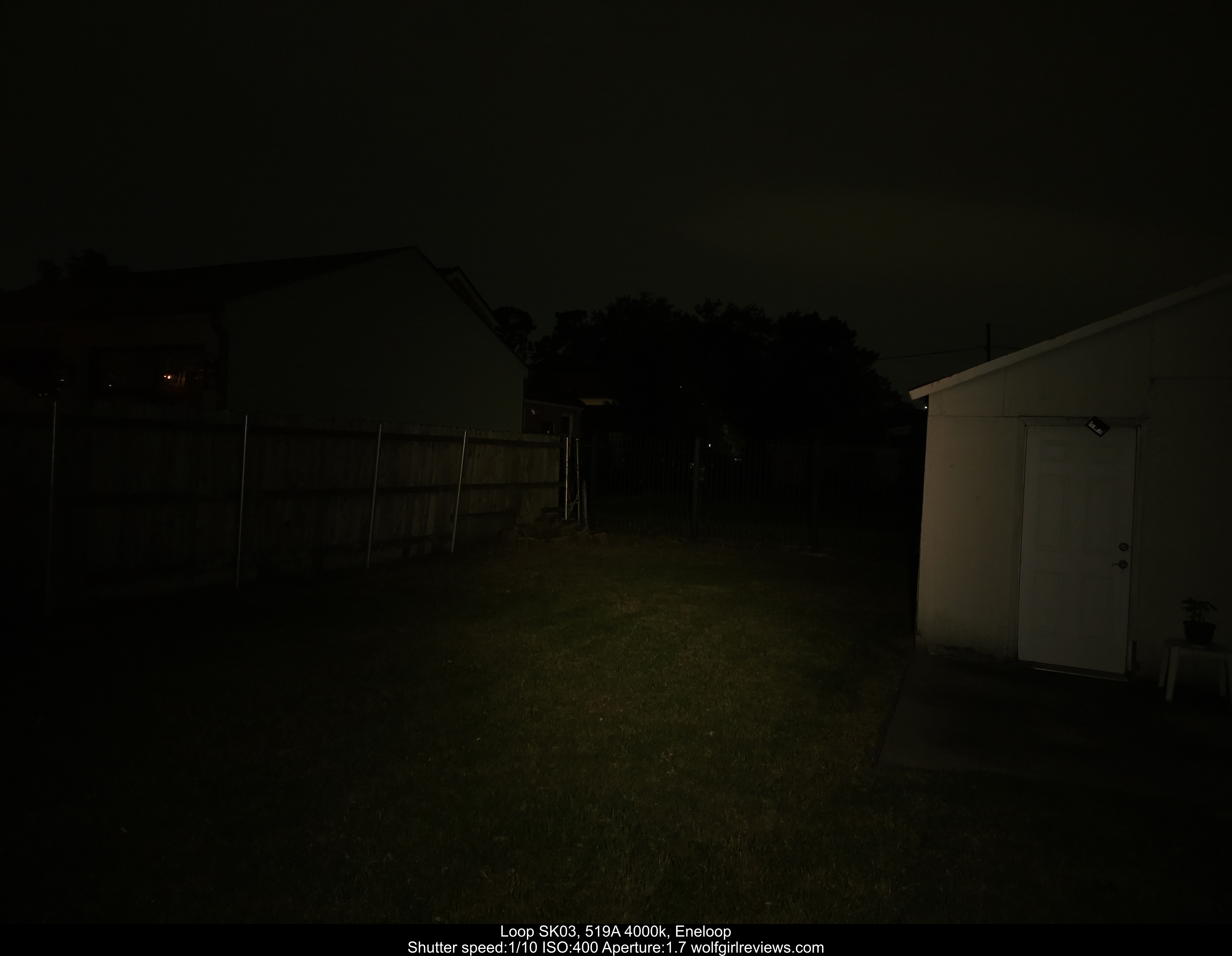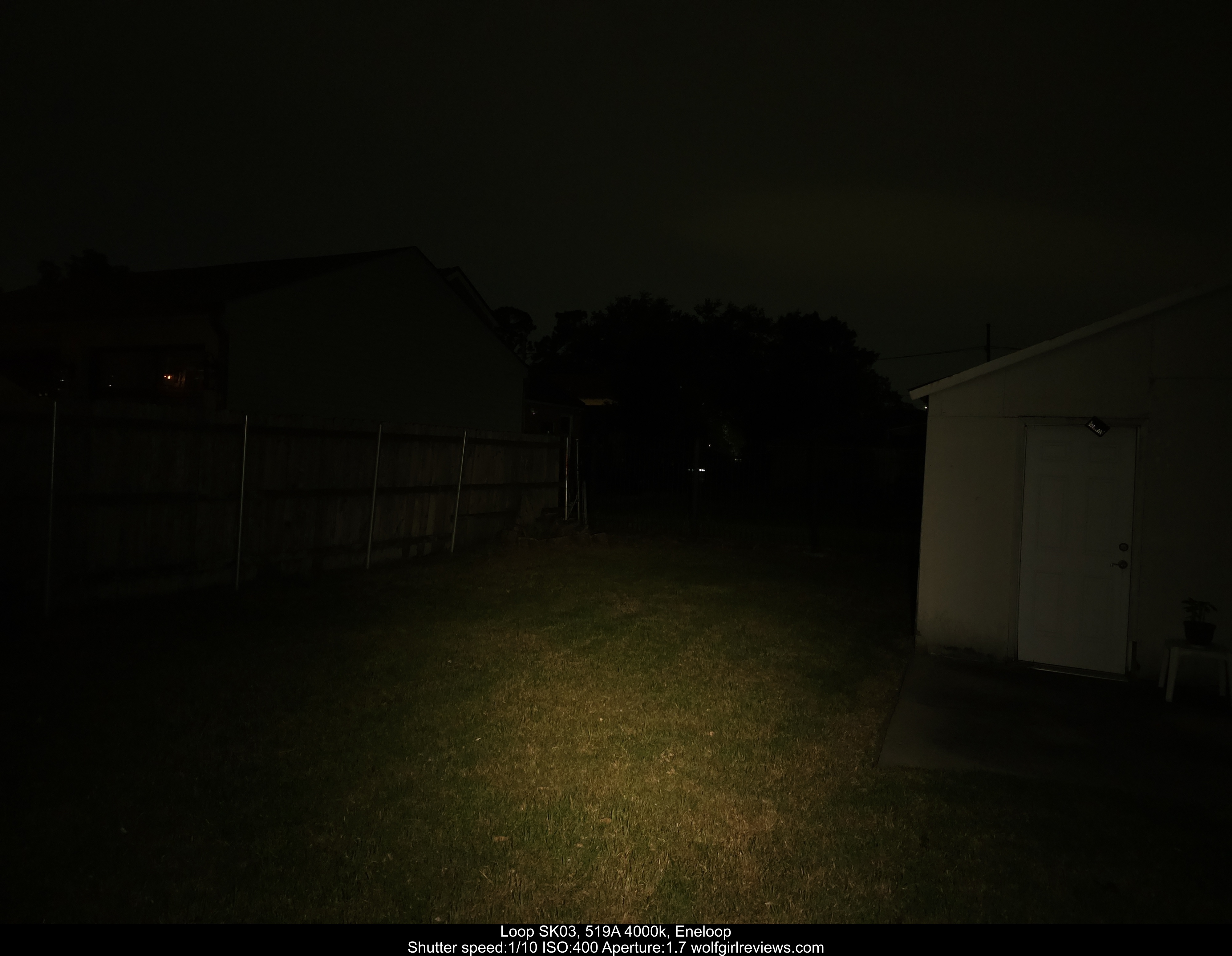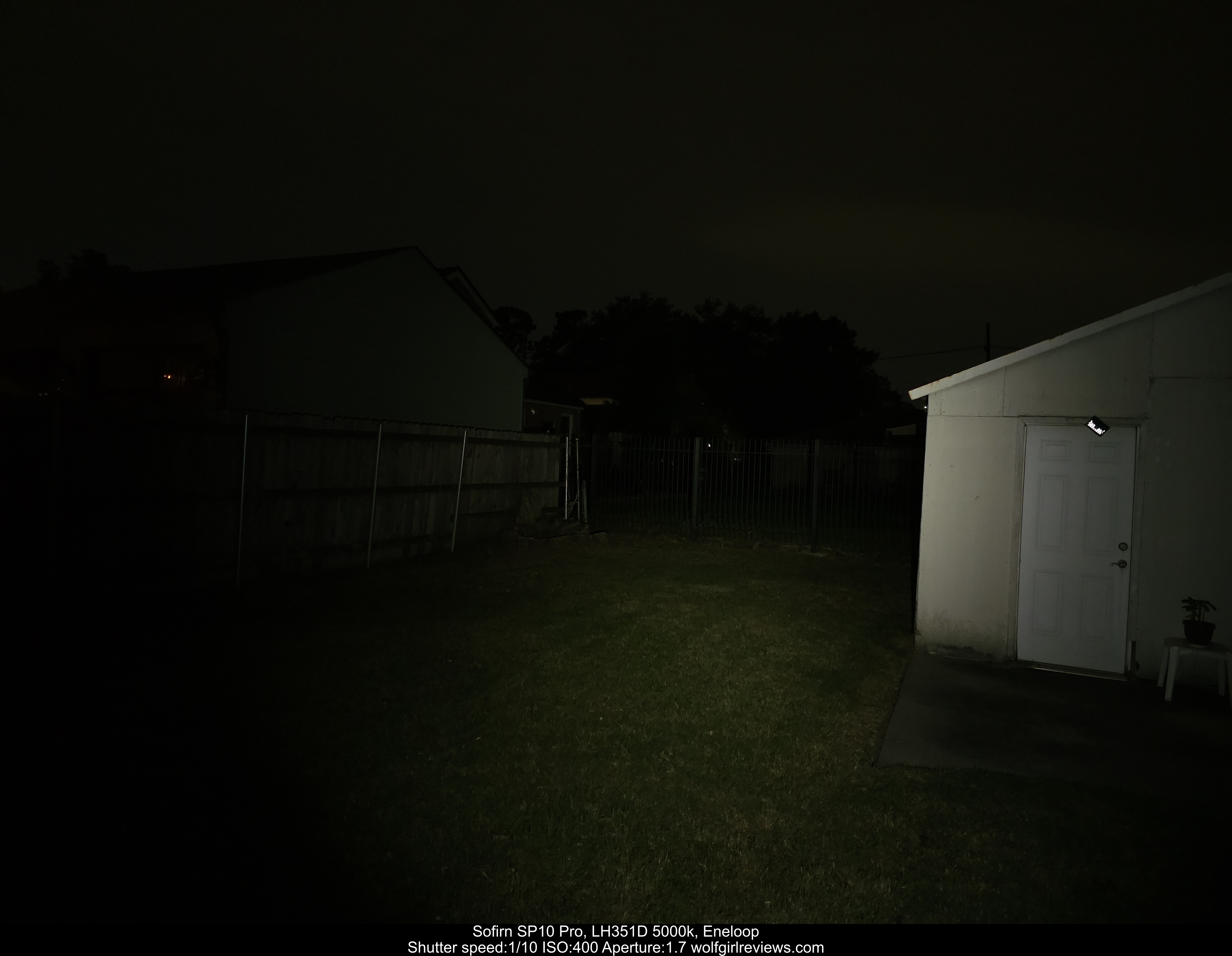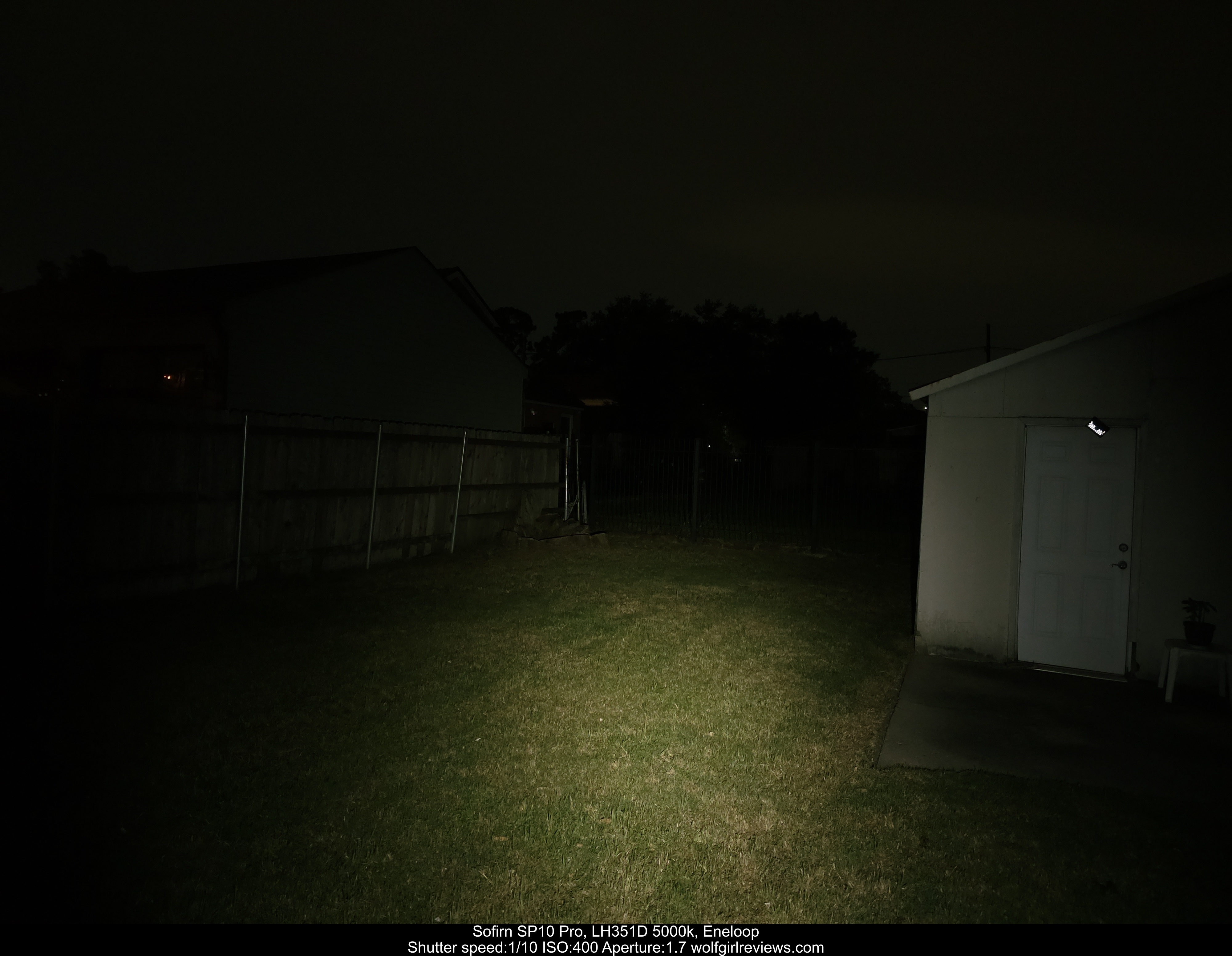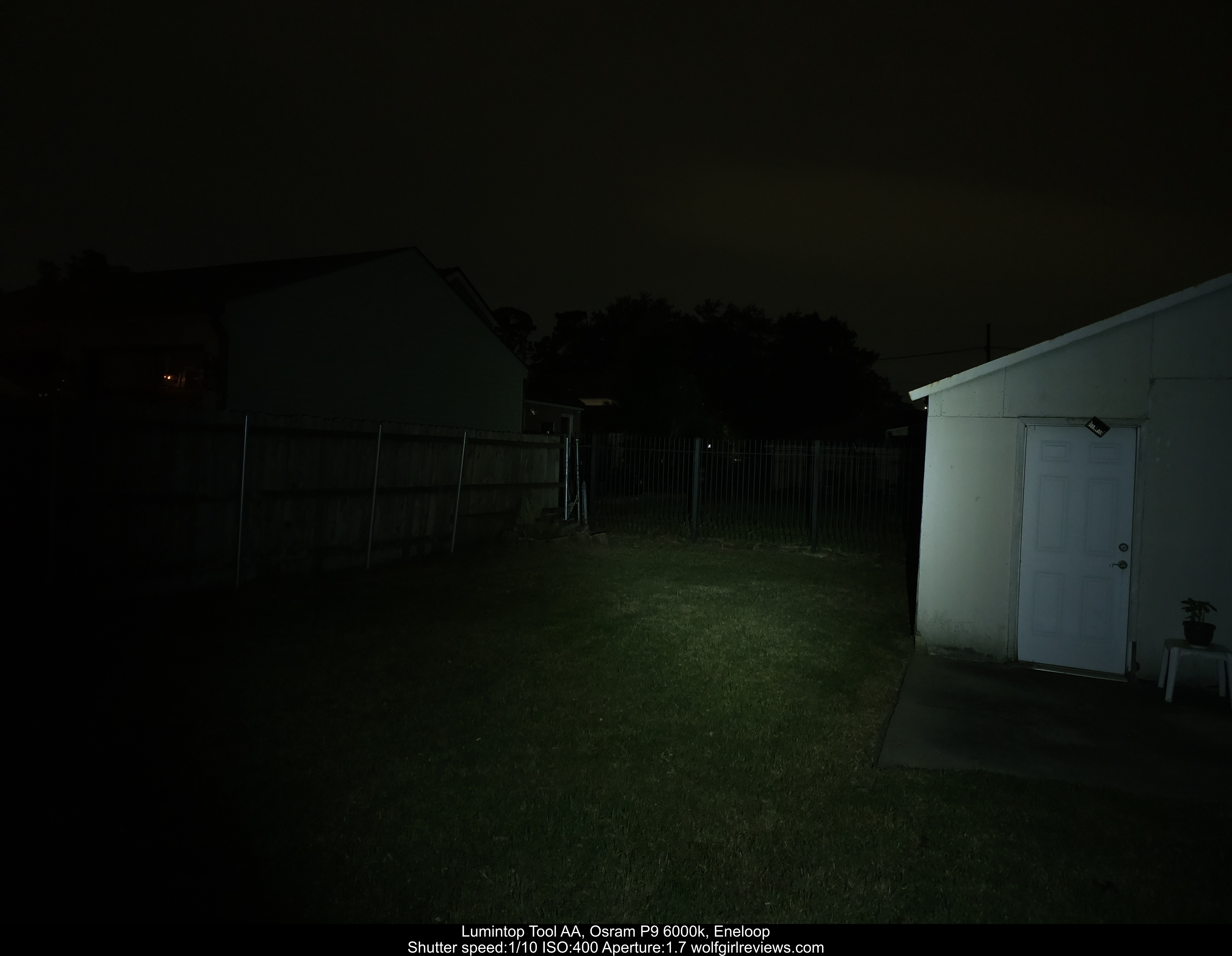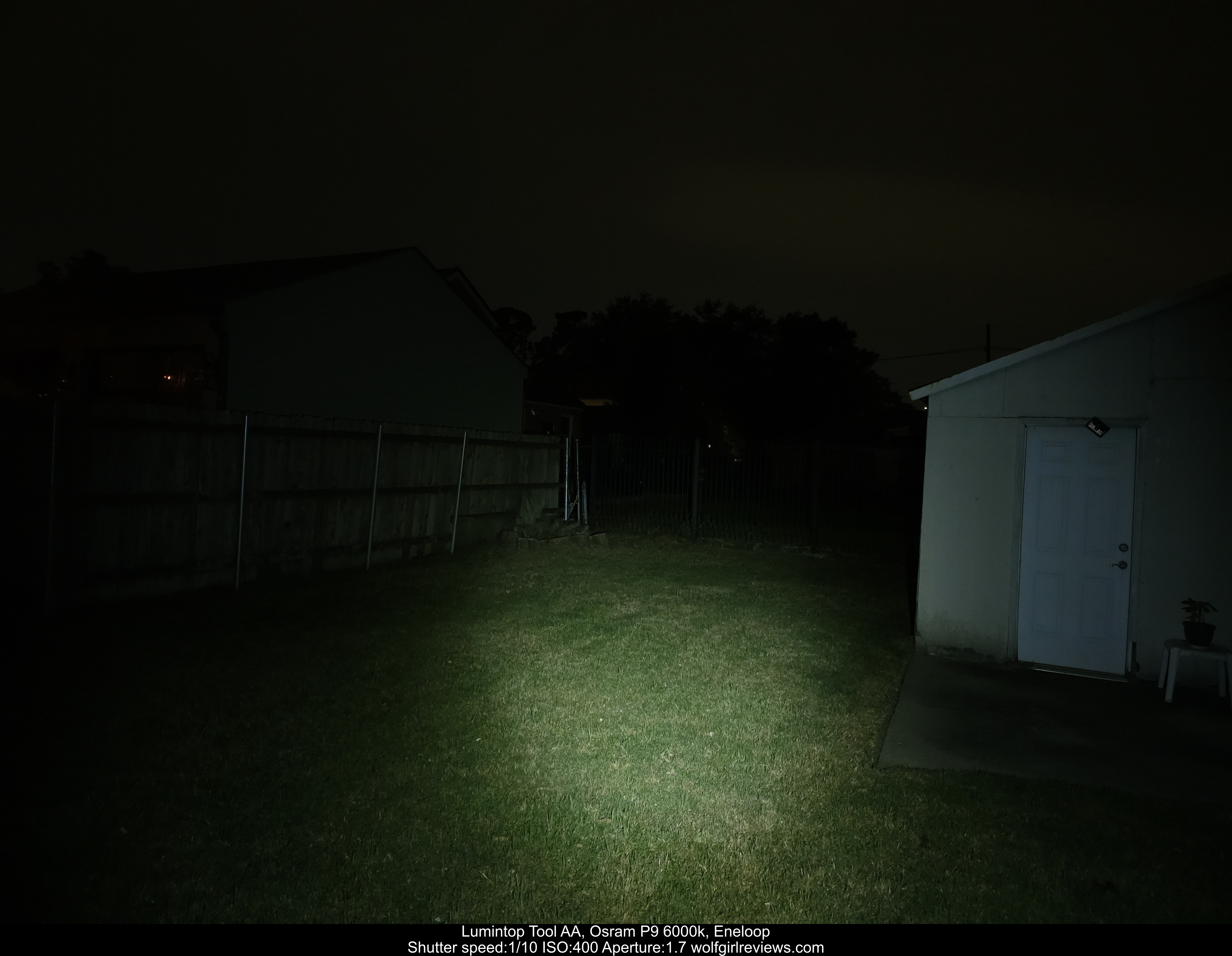"You've heard of forward clickies... This is a forward twisty."
"For those who feel their light could do with a bit more wrist action."
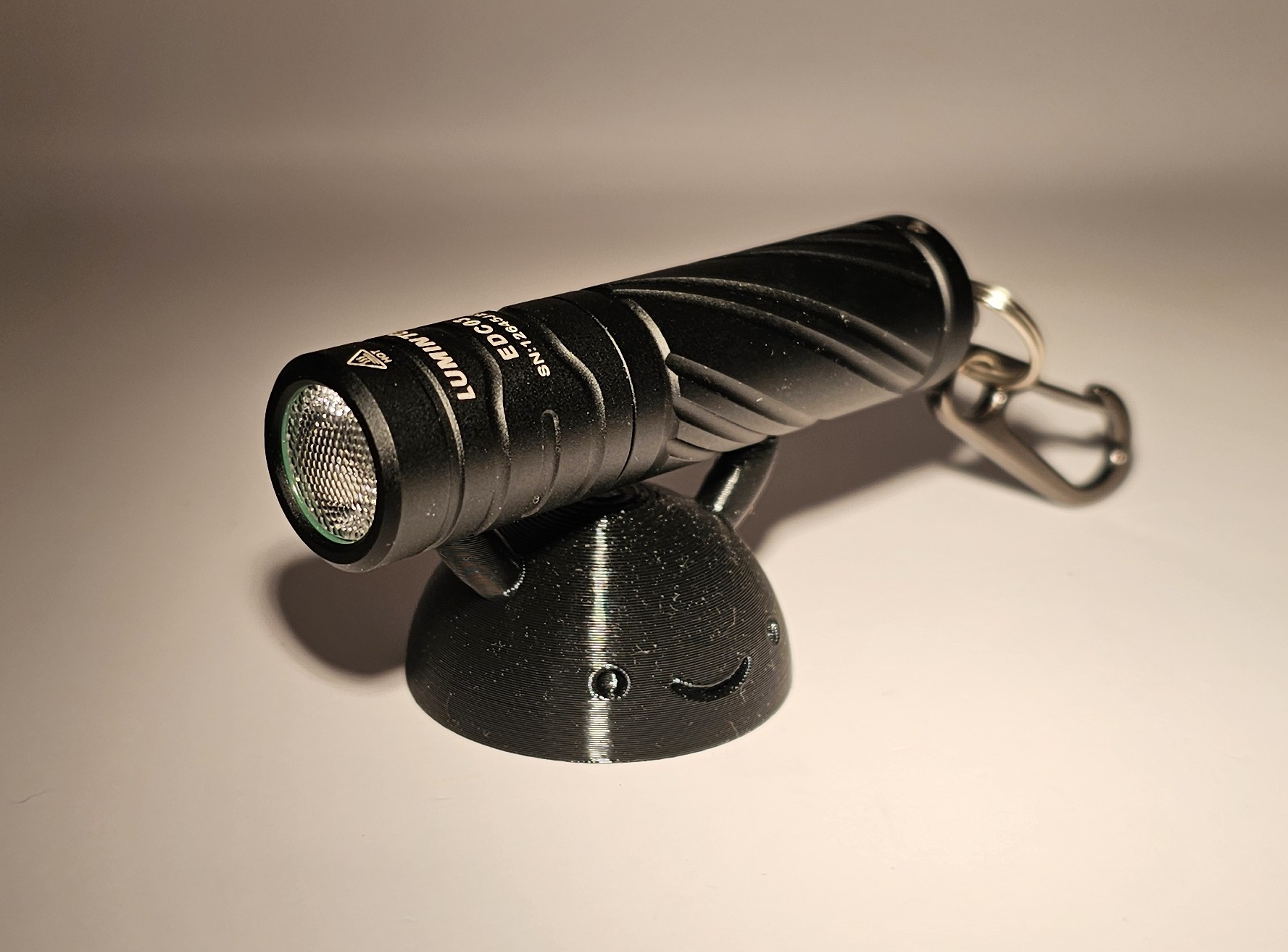 The Lumintop EDC03 is a large keychain light or small EDC light with an Osram P9 and a dual chemistry driver. The EDC03 distinguishes itself by having four different brightness levels in a form factor that most commonly comprises single-mode lights.
The Lumintop EDC03 is a large keychain light or small EDC light with an Osram P9 and a dual chemistry driver. The EDC03 distinguishes itself by having four different brightness levels in a form factor that most commonly comprises single-mode lights.
Introduction, Background, and Official Specs
Lumintop occupy a strange place in the world of lights. They are well known by many enthusiasts for many popular product lines such as the FW series and the BLF GT series, created in collaboration with the enthusiast community, but in the last couple of years, Lumintop has shifted somewhat away from enthusiast-oriented lights in favour of more simple designs, in particular expanding their range of small keychain lights recently with updated versions. The EDC03 is an evolution of the previous EDC02, and keeps the same basic formula with an Osram P9 and multichemistry driver with support for 3.6V 14500 cells as well as 1.2V Ni-MH or 1.5V alkaline cells.
Official specs and test results:
| Parameter | Official Value | Measured |
|---|---|---|
| Output (14500, turbo) | 800 lm | 781 lm |
| Runtime (14500, turbo) | 5 min + 1hr 45 min | 1 hour 7 mins ANSI FL1; 1 hour 11 mins to <1 lm |
| Intensity (14500, turbo) | 1,235 cd (70m FL1) | |
| Output (14500, high) | 450 lm | 501 lm |
| Runtime (14500, high) | 58 mins | 1 hour 21 mins ANSI FL1; 1 hour 24 mins to <1 lm |
| Output (14500, medium) | 130 lm | 113 lm |
| Runtime (14500, medium) | 4 hours 10 mins | 5 hours 20 mins ANSI FL1; 5 hours 27 mins to <1 lm |
| Output (14500, low) | 8 lm | 11 lm |
| Runtime (14500, low) | 50 hours | |
| Output (Ni-MH, turbo) | 320 lm | 283 lm |
| Runtime (Ni-MH, turbo) | 1 hour 5 mins | |
| Output (Ni-MH, high) | 130 lm | 1 hour 21 mins ANSI FL1; 1 hour 25 mins to <1 lm |
| Runtime (Ni-MH, high) | 2 hours 28 mins | 3 hours 12 mins ANSI FL1; 3 hours 15 mins to <1 lm |
| Output (Ni-MH, medium) | 20 lm | 18 lm |
| Runtime (Ni-MH, medium) | 16 hours | |
| Output (Ni-MH, low) | 2 lm | 1 lm |
| Runtime (Ni-MH, low) | 80 hours | |
| IP rating | IP68 | |
| Impact resistance | 1.5 m (4.9 ft) | |
| Weight (without battery) | 28 g | 27.5 g |
General information:
| Parameter | Value |
|---|---|
| Battery | 14500/AA |
| Charging | No |
| Emitters | Osram P9 |
| LVP | On 14500 only |
| MSRP | $22 |
| Price (at time of publication) | $20 |
For runtime testing, I give two figures when possible. The ANSI FL1 runtime is calculated by when the light drops below 10% of initial output. I also attempt to run the light past this to find the point where it switches off automatically if possible. Many lights will run at 1 lumen of less for an extended time before powering off, and with these lights I note my observations on when the runtime test was terminated, and may terminate tests at this point as my current measuring setup has a minimum of 1 lumen. For testing of output, my acceptable margin of error is between 5% and 15%, with margin increasing with output.
I was sent this light for free by flashlightgo.com in exchange for a review. I am using an affiliate link from this review but am not being otherwise compensated for this review, and am giving my honest opinion without holding back on any negative experiences or overstating any positive. I may use affiliate links to Amazon or similar sites for things such as measuring equipment I use, but do not otherwise have any related interest in anything I mention.
First Impressions, Physical Design, and Build Quality
The Lumintop EDC03 comes in a small and relatively plain cardboard box without any details of the light such as specs or picture. Inside, along with the EDC03 itself, with an instruction manual, glow-in-the-dark diffuser, keychain attachment, and two spare o-rings. My review sample did not include a battery, but it is also available with a 14500 battery - this is most likely the USB-C charging protected 14500 Lumintop use in their other small lights, so I used one of these batteries for my testing.
The EDC03 is of average size for a 14500 light in both length and diameter, and completely cylindrical. My review sample was finished in black HA III; a green version is also available which likely uses a standard anodising process. The finish has a slightly matte effect, with no visible thin spots or imperfections. On the front of the light, there is a pebbled TIR optic, which is completely bare with no protective glass lens - you can feel the pebbled texture with your finger. An exposed optic will pick up scratches, although this is slightly more forgivable at the $20 price point than on more expensive lights, particularly since the optic is already extremely floody with no real throw to be affected. There is a glow-in-the-dark o-ring surrounding the optic, although it is thin and does not retain its glow for much more than a couple of minutes at most. The head has no separate bezel or internal pill, so access to the emitter and optic will require removal of the driver. Lumintop have given the EDC03 an IP68 rating for up to 2 metres of submersion.
The usual "HOT" symbol is printed near the top edge, with a series of four shallow cutouts below - these appear to have been designed more for grip than thermal performance. The middle pair of these cutouts shift up and down around the circumference of the head, with an additional cutout inside each wide spot where they move closer to the outer two. The Lumintop logo is printed underneath the first, then "EDC03" and a serial number below the second. When removing the head, there is a button for contact with the positive battery terminal, surrounded by a ring for physical reverse polarity protection, and, surprisingly, a set of flashing pads - there are four in total, labelled +, -, D, and C. These flashing pads do not correspond to those normally used by any common MCUs, but this does mean that custom firmware may be possible.
The body tube is a single piece with no distinct tailcap, and a spring friction fit inside the end of the tube. The threads where it connects to the head are anodised, with the current path through the top edge, and feel very smooth and high quality with only a little detectable roughness in use. This is important consider the EDC03's user interface. The threads on mine came with a few drops of a light oil, although when I added some Nyogel 760G then the feel became smoother and almost perfect feeling. There is a single o-ring before the threads, which fit well and neither became pinched nor was left exposed when the head was tightened down. The body has spiral grooves cut into it, in four groups of three grooves. I found these to provide an acceptable level of grip, although the HA III finish did on occasion feel slightly slippery in my hand and I found myself relying more on the head grooves to actually handle the light securely. Towards the tail end, there are two holes on opposite sides, one of which contains a fastener for the tail magnet.
There is no separate tailcap, but there is a magnetic metal eyelet, which is fixed to the body so that it can rotate freely 360 degrees without unscrewing. The action here is somewhat stiff, taking two hands to rotate. This is clearly designed to be attached to a set of keys or similar object, and allows the EDC02 to be operated by holding the head and twisting the body or moving the items it is attached to more easily than if the attachment point was fixed. There is a small detent at one position (i.e. when rotated every 360 degrees) which makes a noticeable but quiet click sound when rotated past.
Lumintop's warranty is described on their website and has lifetime coverage with the usual exceptions (batteries, emitter lifespan, and damage), although in my experience, Lumintop's customer service has been sometimes inconsistent.
Size Comparison
I took comparison photos of the EDC03 with a range of keychain lights, penlights, and small EDC lights.
- Skilhunt EK1
- Olight i3E EOS
- Skilhunt E3A
- Lumintop GT Nano (10280 tube)
- Emisar KC1
- Wurkkos TS10
- Sofirn SC21 Pro
- Loop SK03
- Lumintop FWAA
- Emisar D3AA
- Sofirn SP10 Pro
- Lumintop Tool AA
- Acebeam Rider RX
- Emisar D4v2 (18350 and 18650 tubes)
- Emisar D2
- Reylight Pineapple Mini
- Lumintop FW3A
- Convoy T3
- Wurkkos HD01
User Interface
The EDC03 is controlled entirely by twisting and untwisting the head. There are four output levels, and cycling through levels is done by tightening the head to switch the light on, then untwisting the head to switch it off, and retightening the head to switch back on to advance the mode, with a 2 second timeout after which the previously used level will remain selected instead. There is also a strobe mode, accessible by switching levels 6 times in a row (without letting the mode selection time out).
Most twisty keychain lights do not have any form of brightness control, other than QTC lights such as Fraz Labs or Peak. The EDC03 works around this limitation by using a UI that overall strongly resembles that of a forward clicky switch. When you tighten the head to switch the light on, it first comes on at the previous mode used. If you loosen and then quickly (within around 2 seconds) retighten the head, it then advances to the next mode, cycling through 4 different modes (low, medium, high, and turbo). The timeout is around 2 seconds - if the light is switched off for more than around 2 seconds, it will instead come back on at the last mode used.
There are no other functions other than a strobe mode, accessed by rotating the head from on to off and back to on 6 times. In my opinion, this does make it a little too easy to accidentally enter strobe mode if cycling through all output levels to find the appropriate one, and going past your intended level and needing to go back around. This can be prevented by waiting around 2 seconds before the 6th mode change, in which case it is performed as normal without activating strobe.
In general, keychain lights are designed more for immediate convenience than for flexibility, and in most cases only have one mode, or occasionally two, so the inclusion of 4 modes here is excellent in comparison.
When using a Ni-MH AA battery, when the battery became very low, the light started blinking rapidly at <1lm. At this point the battery had dropped to 0.8V, which is overdischarged - NiMH batteries have a normal minimum of 0.9V. For this reason, I would recommend to be careful if using Ni-MH, and if alkaline batteries are used, to make certain to remove them after use as overdischarging an alkaline significantly increases the chance of it leaking.
| What it gets right | What it gets wrong |
|---|---|
| Interesting interface concept, with multiple modes in a keychain light | No LVP for 1.5V batteries |
| Timeout for mode switching feels reasonable for general use and did not get in the way | Too easy to accidentally enter strobe mode |
Using the Light
The EDC03 is certainly a keychain light in form factor, but on the large side within the general size category, but does at least compensate for this with respectable output. The magnetic keychain loop at the tail end of the light is an interesting choice, as the light is able to hang from metal surfaces by it without a problem even without the key loop attached, but in my opinion does prove annoying if actually attached to keys, as it will cause all your keys to bunch up at that spot.
The knurling on the head is well designed and feels comfortable while providing sufficient grip - very important in this case due to needing to twist the head to adjust output level. In the body, the spiral knurling does take some getting used to. Both are shallow enough that using the EDC03 with thin gloves on is not a problem, but thicker gloves may prove more difficult. The threads on the head are relatively fine - this gives a lot of room for loosening the head to turn the light off without worrying about it falling out, but does make reinstalling the head after a battery change more difficult, as it takes a little extra time to line them up.
Overall, this is a very floody light, and lacks both the power and the candela for me to consider as a full-on EDC light, but it absolutely outperforms a phone's light for general purpose usage, and on turbo or high has enough power for walking at night, as long as you limit your targets to relatively close to you, particularly as there is a very steep thermal stepdown after just over a minute, from just over 600 lm to below 400 on turbo, and the 14500 battery does limit extended use on high settings.
That said, there will always be a group of people who swear by 14500/AA dual-chemistry lights as the best thing ever and think that alkaline batteries will always be available forever even in a disaster (despite my own experience to the contrary), and for people of that mindset, the dual chemistry functionality is a big plus, as AAs can always be used in an emergency situation. In general, due to the lack of proper LVP, I would recommend against using alkaline batteries in all but an emergency, as they are likely to leak and particularly so when overdischarged, but if you keep an eye on the actual output performance, 1.5V performance is reasonably usable, and in my opinion still marginally better than many phones.
When run on turbo, the EDC03 heats up very quickly, as expected from a high powered keychain light, reaching a peak of 63 degrees after around 90 seconds. With the control mechanism, the user's hand's heat tolerance is likely to be the limiting factor before this point, although sustained performance at this output level is not sufficient for it to remain this hot for long.
Driver and Emitters
The EDC03 seems to use a linear for the 14500 battery, as the output shows relatively poor regulation and drops with battery charge once the light has heat soaked. The 1.5V driver is, as is inherently necessary for 3V white LEDs, a boost driver, and shows much better regulation after the thermal stepdown, with output almost perfectly flat until the battery is almost entirely depleted.
The emitter is an Osram P9. This is a floody cool white emitter that has become increasingly common as a way to maximise output on many small budget lights, as it offers high efficiency and output with a nicer beam than some of Cree's comparable offerings. The emitter is cool white and low CRI, but combined with the very floody optic, the resulting beam is mostly even and smooth, with just a little green tint shift evident in the hotspot. Some angular tint shift is present, but minimal to the point only the most dedicated white wall hunters are likely to notice it, and chances are a 6000k 70 CRI emitter is not their weapon of choice... In my opinion, the EDC03's beam is going to be more than sufficient for any casual use.
I measured the EDC03's CCT and CRI with a Colormunki Photo and ArgyllCMS.
CRI and tint
Power and Charging
There is no built-in charging. With a dual chemistry driver, 14500 or Ni-MH AA batteries can both be used, as can AA alkaline batteries, although I would recommend against those except for an emergency.
My review sample did not come with a battery, but Lumintop's 14500 lights are generally offered with a battery option, which to my knowledge has always been the same battery, a Lumintop-branded protected 14500 battery with a built in USB-C port, rated at 920mAh. This is a common cell that is sold wrapped as several brands - I have the same cell branded as Lumintop, Acebeam, Loop, Manker, and several others.
For my Ni-MH battery testing, I tested with Eneloop Pro and found no difference in output to standard white label Eneloops, so all Ni-MH tests were performed with these batteries.
There is a raised metal ring to act as physical reverse polarity protection - this also means that flat top batteries do not work in the EDC03 and button top must be used. Notably, I tried using one of Simon's 14500 flat to button top adapter/spacers and this did not work, as the reverse polarity protection ring is too tall and it was not able to make contact with the button on the driver. As such, I would recommend buying the EDC03 with Lumintop's bundled battery.
Moddability and Repairability
Two words: "Good luck!"
The EDC03 does not have any obvious bezel, so the emitter and its MCPCB as well as the optic are likely installed from the rear of the head. The driver appears to be glued in place. The tailspring is press fit into the single piece body, although the magnet itself appears to be in the keychain loop and not accessible through the body tube, and the assembly of the loop is clearly not designed for disassembly.
As already mentioned, the EDC03 has a set of flashing pads - there are four in total, labelled +, -, D, and C. These flashing pads do not correspond to those normally used by any common MCUs, but this does mean that custom firmware may be possible.
Performance
All lumen measurements taken using a 4.5 inch Texas Ace lumen tube. Candela measurements were performed indoors at a distance of 3m, using a UNI-T UT383BT datalogging luxmeter.
Runtime tests were performed using the lumen tube's HS1010A luxmeter, which the tube is calibrated for, with data recorded via taking a video, exporting the individual frames using ffmpeg, and parsing the value on the luxmeter's display at the appropriate frame for each measurement. I logged the value every second for the first 5 minutes, then every 5 seconds up to 30 minutes, then every 30 seconds past that point.
Output and Throw
| Mode | Spec | Peak output | Output after 30s | Output after 1 minute | Output after 90s | Output after 5 minutes | Output after 15 minutes |
|---|---|---|---|---|---|---|---|
| Turbo, 14500 | 800 lm | 781 lm | 657 lm | 623 lm | 615 lm | 384 lm | 334 lm |
| High, 14500 | 450 lm | 501 lm | 465 lm | 449 lm | 440 lm | 356 lm | 314 lm |
| Medium, 14500 | 130 lm | 113 lm | 111 lm | 111 lm | 110 lm | 107 lm | 104 lm |
| Turbo, Eneloop | 320 lm | 283 lm | 282 lm | 282 lm | 154 lm | 153 lm | 153 lm |
| High, Eneloop | 130 lm | 81 lm | 81 lm | 81 lm | 80 lm | 79 lm | 79 lm |
| Mode | Spec | Peak candela | Candela after 30s | Candela after 1 minute | Candela after 5 minutes |
|---|---|---|---|---|---|
| Turbo, 14500 | 1,235 cd (70 m) | 1160 cd (68 m) | 1028 cd (64 m) | 973 cd (62 m) | 572 cd (48 m) |
| High, 14500 | (not specified) | 640 cd (51 m) | 616 cd (60 m) | 608 cd (49 m) | 468 cd (43 m) |
| Turbo, Eneloop | 1,235 cd (70 m) | 404 cd (40 m) | 404 cd (40 m) | 400 cd (39 m) | 216 cd (29 m) |
| High, Eneloop | (not specified) | 100 cd (20 m) | 100 cd (20 m) | 100 cd (20 m) | 100 cd (20 m) |
Runtime
| Mode | Spec | Runtime |
|---|---|---|
| Turbo, 14500 | 5 mins + 1 hour 5 min | 1 hour 7 mins ANSI FL1; 1 hour 11 mins to <1 lm |
| High, 14500 | 58 mins | 1 hour 21 mins ANSI FL1; 1 hour 24 mins to <1 lm |
| Medium, 14500 | 4 hours 10 mins | 5 hours 20 mins ANSI FL1; 5 hours 27 mins to <1 lm |
| Turbo, Eneloop | 1 hour 5 min | 1 hour 21 mins ANSI FL1; 1 hour 25 mins to <1 lm |
| High, Eneloop | 2 hours 28 mins | 3 hours 12 mins ANSI FL1; 3 hours 15 mins to <1 lm |
Performance Overview
As expected from such a small light, the thermal stepdown is fairly large and happens early into the run. In 14500 mode, output does not have stable regulation and steadily drops with battery after the EDC03 has heat soaked. Despite this, the EDC03 holds a usable output for a reasonable time when the battery is low, only dropping off to 0 sharply towards the very end before LVP starts.
The boost driver used for 1.5V cells shows much more stable output, with output remaining flat after thermal regulation until the battery is almost entirely empty (although I would not recommend running it to empty as this driver does lack LVP, discharging Eneloops to 0.8V where the light was only capable of an intermittent blinking output.
Beamshots
| Light | Emitters | Notes |
|---|---|---|
| Emisar D3AA | 519A 5700k | Tested at 1800 lm with 14500, 600 lm with eneloop |
| Reylight Pineapple Mini | 519A 4000k | Tested at 350 lm |
| Acebeam Rider RX Ti | 519A-V1 5000k | Tested at 700 lm, 280 lm with eneloop |
| Loop SK03 | 519A 4000k | Tested at 780 lm with 14500, 250 lm with eneloop |
| Sofirn SP10 Pro | LH351D 5000k | Tested at 795 lm, 350 lm with eneloop |
| Lumintop Tool AA 3.0 Ti | P9 6000k | Tested at 1100 lm, 375 lm with eneloop |
| Wurkkos TS10 | CSP2323 6000k | Tested at 1400 lm |
EDC03 (14500)
Comparison Beamshots (li-ion)
EDC03 (Eneloop)
Comparison (eneloop)
Competitors
Lumintop Tool AA, Acebeam Rider RX: Similar 14500/1.5V lights, with a tailswitch and a more traditional clicky UI, and marginally better performance, but more of a traditional penlight form factor rather than a keychain light.
Emisar D3AA: A more enthusiast-oriented option that is shorter but wider than many penlights, with excellent performance, a wide range of LED options, and a very high efficiency boost driver with both 14500 and 1.5V support.
Wurkkos TS10: Another enthusiast option, with very high value for money, but only takes 14500.
Emisar KC1: Smaller, single mode only, 10440/AAA keychain light.
This section does not list all possible alternatives, is subject to my own interest and views on listed lights, and is primarily intended to give a general overview. A light not being included here does not mean it should not be considered a viable alternative.
Potential Improvements
- Emitter options: Some enthusiasts favour a warm or neutral LED, but also, an Osram W1 (CSLNM1.TG) could be used for more throw performance with a different optic.
- Strobe mode: Could be made harder to accidentally access, perhaps increasing the number of twists to access.
- Battery check mode: Could be implemented similarly to strobe mode in activation
- LVP while using 1.5V batteries
- Reverse polarity protection: Could be implemented on the driver instead of using a physical ring, or the ring's size adjusted to work with more batteries
Final Thoughts and Score
| Category | Score | Comments |
|---|---|---|
| Looks | 7/10 | The EDC03 has a relatively unique design and an interesting optic - there is nothing bad but also nothing strongly special. The cutouts work well both aesthetically for grip, and the general feel in the hand matches the looks well. |
| Quality | 7/10 | The finish seems reasonably well done and held up well during testing. The TIR optic does not have any glass in front of it, which is a noticeable negative, although less critical in this case due to the optic's floody beam profile. I did occasionally have a little trouble when reinstalling the head after battery changes as the threads are relatively fine and it can be hard to find the start. |
| User Interface | 7/10 | Multiple modes on a twisty keychain light is rare, and the UI is reasonably well implemented except for the strobe mode that is relatively easy to accidentally access, and the lack of LVP for 1.5V batteries. |
| Performance (absolute) | 6/10 | Performance is comparable to other similarly sized 14500 and dual chemistry lights as far as initial output goes. |
| Performance (sustained) | 5/10 3.6V, 7/10 1.5V | 14500 performance is decidedly average, but 1.5V performance shows reasonably high efficiency and very stable regulation. |
| Moddability and repairability | 3/10 | There is no obvious easy way to get into the head of the EDC03, and the tailcap is clearly not designed to be disassembled. |
| Practicality | 7/10 | The EDC03 is not the smallest of keychain lights, but it makes up for this with the higher battery capacity of 14500 over 10440, sitting somewhere between keychain light and penlight in size. I do find the magnetic tail both a positive and a negative, as while it is able to stick to metal objects well, it will also attach itself to keys if used as a keychain light, and the loop makes it unable to tailstand if not being used as a keychain. |
| Value | 7/10 | $20 is a reasonable price for a medium performance 14500 light, although some with higher performance such as the Lumintop Tool AA are only slightly higher priced, but the EDC03 is overall still priced comparably to many smaller and lower performing keychain lights. |
| Overall | 7/10 | The EDC03 is a very interesting concept, with reasonable performance for the size and good value for money, occupying a relatively small space of lights smaller than penlight size with multiple output modes. The EDC03 is more likely to be a light for non-enthusiasts, so the addition of 1.5V compatibility here could be considered helpful, although I would always recommend to buy it with the Lumintop 14500 battery as some of my other 14500s did not fit. |
The EDC03 is available from flashlightgo, as well as directly from Lumintop, but at the time of writing is not yet available widely from other sellers.
For a 10% discount from flashlightgo, use discount code wolfgirl.
As always, feedback is welcome - I am active on BLF or Reddit, both on /r/flashlight and other specific subreddits, and have started my own subreddit for review content at /r/WolfgirlReviews.
>> Home










































